edible INDY
Celebrating the Bounty of Bloomington, Carmel, Columbus, Indianapolis and Beyond
Eat. Drink. Read. Think. Local.





Dinner with a side of adventure.
Dining
chefs,














Celebrating the Bounty of Bloomington, Carmel, Columbus, Indianapolis and Beyond
Eat. Drink. Read. Think. Local.





Dining
chefs,













Summer is here. Green grasses, trees in full bloom and an abundance of fresh foods come alive, giving us the juiciest tomatoes, the hottest peppers, the most flavorful herbs— and who doesn’t want fresh strawberry shortcake with bourbon ice cream?

In this issue we have worked hard to bring you new places to visit, to call your favorite, to call home. We welcome you to entertain your friends and family with the amazing recipes from our latest contributors, A Couple Cooks. And we introduce you to the hottest drink trend, shrubs (even though they date back to the 15th century). Our friend Kendall Lockwood at the Ball & Biscuit never disappoints us when we ask her to teach us something new, and to quench our thirst for a cocktail you can drink all summer long.
We bring you our love of cooking through our partnership with the Edible Indy Kids’ Table free cooking classes sponsored and hosted by Georgetown Market and also our Edible Market District Classes. In April, we hosted our Knife Skills 101 class and we will be hosting four other classes onsite in the Market District Cooking School. These classes will provide our community with affordable, fun and hands-on experience. In addition to these classes, we welcome in this issue our 2016 partnership with the Hoosier custom knife makers, Ash Blæds. In each issue they will provide our readers with great knife education to further enjoyment of cooking and the legacy of a good knife.
Our summer is packed full, folks, and we once again say Happy Birthday both to Indiana and also to the Indianapolis Motor Speedway. If farm markets, blueberries and great cocktails don’t get you in the mood for summer, ladies and gentlemen, start your engines and let the 100th running of the Indianapolis 500 do it for you. These, these, my friends are Indiana … in the summer.
Hoosier Hugs,
Jennifer & Jeff Rubenstein


When I was in college, one of my friends told me that she knew the family that painted the Golden Gate Bridge. She said it took them an entire year to paint it, and when they were done, they just started all over again. I have no idea if this story was true, but I think about it a lot. And sometimes, I think “How awful and boring—to finish and start over doing exactly the same thing over and over again!”
But then I think about it—is it ever really exactly the same? Wouldn’t they see something new every day as they painted? A different sunset every night as they were finishing up? A new load of cargo passing on a ship below? A breeze that only they could feel way up there, different than the breeze down here?
And that’s how I feel about Edible Indy. Yes, right now I’m doing the same tedious things I’ve done since my first issue nearly two years ago: removing Oxford commas, checking the names of businesses and fact checking with vigilance. But, I’m also learning about shrubs, wine labels, chefs, root beer and Davis Gardens.
Just like those painters want us to admire the beauty of the paint they apply to the Golden Gate Bridge, I want you to see consistency and value through editing in each article in and issue of Edible Indy—and, of course, I want you to enjoy a good story. Along the way, I get to see my own sunsets, my own cargo ship passing below and feel my own breezes.
All best,
Rachel D. Russell Managing Editor


publisher Rubenstein Hills LLC
editor in chief Jennifer Rubenstein cfo Jeff Rubenstein
managing editor Rachel D. Russell
copy editor Doug Adrianson
designer Cheryl Angelina Koehler
web designer Edible Feast
staff Caryn Scheving, Graphics
advertising Katie Hopper, Assistant Managing Editor katie@edibleindy.com
Jennifer Rubenstein
jennifer@edibleindy.com
317.489.9194
Please call or email to inquire about becoming a member of our advertising partnership and show your support for the local food culture in Central Indiana.
edible indy test kitchen sponsor Market District
edible indy knife sponsor Ash Blæds
contact us
Edible Indy PO Box 155
Zionsville, Indiana 46278
317.489.9194
info@edibleindy.com
Edible Indy is published quarterly (March, May, September and November) with a 5th special edition issue in 2016. Distributed throughout Central Indiana and by subscription elsewhere. Subscriptions are $32 for one year and can be purchased online at EdibleIndy.com or by check to the address above.

Every effort is made to avoid errors, misspellings and omissions. If, however, an error comes to your attention, then you probably have not had enough wine with your healthy food. Please accept our sincere apologies and, if it’s important, please notify us! Thank you.
No part of this publication may be used without written permission from the publisher. © 2016 all rights reserved.
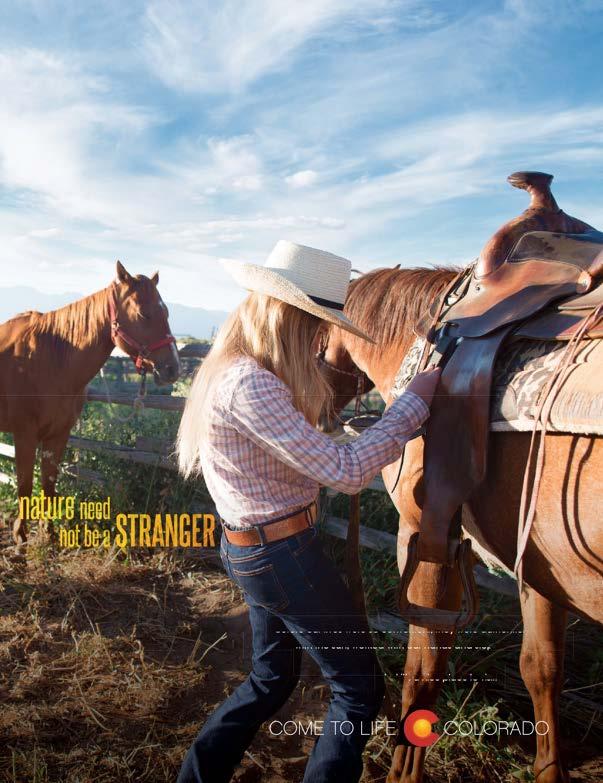
but it’s a nice place to visit. Before our lives were so convenient, they were authentic. We woke with the sun, worked with our hands and slept under the stars. That may not be where we live anymore, Get

Open Society Public House will be a specialty coffee and wine bar serving South American–inspired dishes. The Public House will be located on the southwest corner of 49th and College in the Meridian-Kessler neighborhood that has become known as SoBro. Open Society blends classic Latino cultures and local Indiana roots with a modern-industrial style. Open Society strives to offer a communal experience, delivering the highest standards of refined technical service and gracious hospitality. Open Society will open with its full coffee program seven days a week, while hosting reservation-based dinners and growing to full service by Race Weekend.

The Sycamore by Mallow Run
Mallow Run Winery, located in Bargersville, announces the grand opening of a new event venue, The Sycamore at Mallow Run. Located just a quarter mile west of the winery, the newly constructed building will offer over 12,000 square feet of premier event space perfect for weddings, parties, showers, expositions, business meetings, luncheons and much more. Located less than 20 miles south of downtown Indianapolis, The Sycamore is surrounded by vineyards and natural elements, with three event spaces offering elegance and flexibility that can accommodate gatherings grand and large or small and intimate. Whether you are expecting 25 guests or over 200, thinking of a rustic theme or an elegant black-tie affair, The Sycamore can provide guests the space and amenities to make any occasion memorable. Now booking for July 2016 and beyond. Visit SycamoreEvents. com for more information.
The Garden Table on Schedule to Open Second
It will be brunch-focused, similar to the Broad Ripple location, but will also feature a full espresso bar with fresh house-baked pastries daily and a to-go section with juice, premade salads and sandwiches for those on the go. They will have a full bar, and will be open for small plates into the evening, and then eventually roll out full dinner. They will also have kombucha on tap that can be bought by the glass or growler.



Natural Born Juicers has announced a partnership with Broccoli Bill’s, a fresh produce and specialty grocery store located at 15009 N. Gray Road in Noblesville. Sometime in late summer, they will begin to carry the cold-pressed non-HPP juices from NBJ. Their juices are currently carried by Wildwood Market and Goose the Market in addition to the NBJ location on Massachusetts Avenue in downtown Indianapolis.

This summer, local beverage entrepreneur Erin Edds is introducing the “Softer Side of Hard Soda.” Garden Party Botanical Hard Sodas are available in two flavors: Garden Party Ruby (ginger soda infused with hibiscus and pomegranate) and Garden Party Violet (lemon soda infused with lavender and blackberry). Garden Party Botanical Hard Sodas are great for a day at the beach, park, racetrack or just to hang out and share with friends.



@NewfangledCandy


Proud to make this list of #candy memory makers in Indiana. @edibleindy #edibleindy
@FBPhotogLLC mornings with @beecoffeeroasters and @ edibleindy.Happy Friday! #myfix #coffee #latte #espresso #latteart #drinklocal
@julieyates5
Congrats @EdibleIndy for endorsement of Indiana Bicentennial Legacy Project for sharing history @Indiana2016
amywiseman_1
I love the #HotelTango staff. So nice and welcoming and forthcoming with recommendations. This is the Coroner’s Bribe: their own orangecello with blood orange juice, habanero simple syrup, lemon and bitters. Fantastic cocktail. #FletcherPlace #Indianapolis #Cocktails #Orangecello #EdibleIndy #HoosierBooze
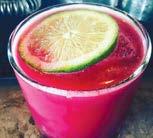
jc_culinary
Cast-Iron Seared Chilean Seabass | Garlic Chives | Tomato Broth | Local Shiitake Mushroom #indychef #edibleindy #localchef

mainstandmaple
Talking about the Color Me Orchid exhibit on Main St. & Maple today. Check out the link in my bio, if not for any other reason, for some dropdead photos of flowers. Heading to the coffee shop next to put some work in on DARK PLACES - my #buddy read with @leslieslibrary & @ thebooksonmyshelfs #edibleindy








Indoor/Outdoor Systems Lights Started Plants & Seeds Fish (Edible & Ornamental) Pumps Plumbing Do-It-Yourself Kits System Installation Come


BY MEREDITH LEE | GRAPHIC BY CARYN SCHEVING
In the early 1800s, Hoosiers were isolated from each other and Indiana was disconnected from the rest of the country. There were just a handful of wagons that carried goods to and from Indianapolis. A single passenger stagecoach brought people from all over the state to collect goods from the capital.
In 1829, U.S. Route 40 transformed the remote state of Indiana into the Crossroads of America; it was the first federally funded highway and it traversed the entire United States. It ran from east to west and facilitated transcontinental traffic through the middle of the country.
Construction began in 1811 and 18 years later, the roadway reached Indiana. The Hoosier stretch of U.S. Route 40 passed through cities including Richmond, Indianapolis and Terre Haute. Around the same time, the north-south U.S. Highway 41 was built. An intersection of U.S. Route 40 and U.S. Highway 41 fell in Terre Haute. That point of intersection was named the “Crossroads of America,” and features a historical marker.
As people traveled westward to build new lives, they crossed through Indiana using the newly built U.S. Route 40. Families had all of their earthly belongings in tow, including household furnishings, children, cattle and more.
The roadway revolutionized mail carrying. At the start of the 1830s, an early version of the Pony Express utilized the road. By 1837, a more efficient system of mail delivery allowed mail coming from Washington, DC, to reach Indianapolis in just a few days.
Teamsters hauled freight day and night using Conestoga wagons with six-horse teams. For Hoosiers, the transportation of goods was especially remarkable because it linked Indiana’s agricultural growers and producers to the rest of the country.
Freight wagons carrying products competed for space with travelers, mail carriers and herds of cattle that were driven to market. At times, traffic was so heavy and constant that the roadway was clogged. Along the Indiana stretch of the roadway, the rumble of wheels was audible from morning until night.

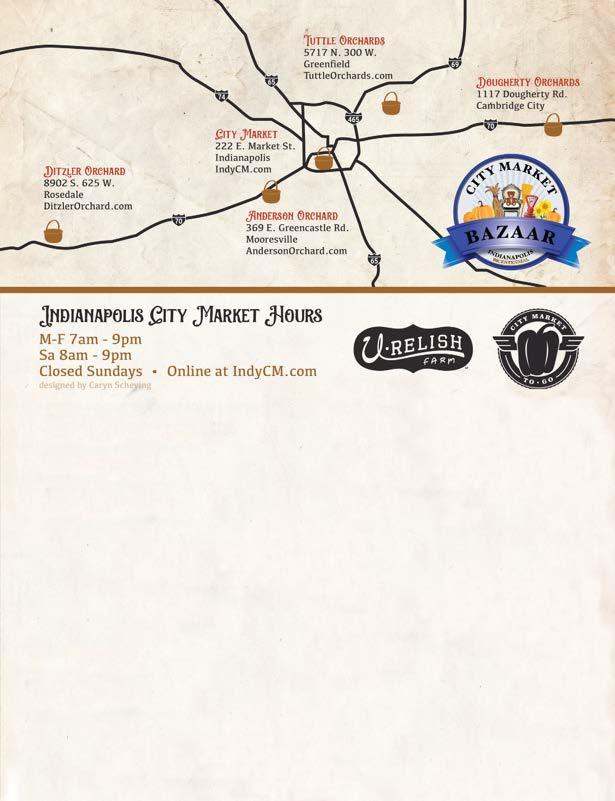
During the “golden age of automobiles,” (1920–1950) U.S. Route 40 carried more traffic than any other highway. When travelers wanted to go from East Coast to West Coast in the 1900s, U.S. Route 40 was the most efficient way to do it.
In its prime, U.S. Route 40 stretched from Atlantic City to San Francisco. When the Interstate Highway System was formed, many western sections of the route were decommissioned and they disappeared from roadmaps. But in many states, including Indiana, groups of people are joining together to recognize the significance and recover the spirit of the historic roadway.
Cara Daffron of U-Relish Farms (an Indiana artisan food producer) is inspired by the connective benefit of Indiana’s historical stretch of road, and she invites others to get involved.
“This is an invitation to travel the U.S. Route 40 to support the growers, producers and artisans along the historic road,” Daffron said. “U-Relish farm is excited about agritourism in our Great State of Indiana.”
She encourages travelers to drive the length of Indiana’s stretch of U.S. Route 40, stopping at the yard sales, markets, flea markets, growers, producers and artisans that are situated along the way.
“There are yard sales and a flea markets that take place on U.S. Route 40,” Daffron said. “Terre Haute and Richmond were significantly impacted by the roadway back then and they still are today.”
For markets and growers like the Indianapolis City Market, Ditzler Orchard, Anderson Orchard, Tuttle Orchards and Dougherty Orchards, their U.S. Route 40 location encourages a sacred economy of connectivity.
“The route creates business and capital arrangements for mutual growth, while at the same time furthering agriculture and tourism,” Daffron said.
Encouraged by all of the history and localism of U.S. Route 40? Take a trip and visit some of the local established businesses on this historic route.
Meredith Lee is a 20-something living in Indianapolis. For work, she is a freelance writer. For play, she swims, practices yoga and replaces bad habits with good ones. For dinner, she prefers dessert.

• • Hosted by Georgetown Market • •
Connect your kids with healthy, scratchmade recipes made with local ingredients.
20 spots available each class - RESERVATIONS REQUIRED
May 14, 2016 Get your Granola on!
Aug 20, 2016 Greenlicous! Making salads & homemade dressing Oct 22, 2016 Pizza Party! Making healthy, fresh pizzas Reserve your spot here: edibleindykidstable.eventbrite.com Ages 6-13 • 10am-12pm
Sponsored by:





BY LISA BANU
Indiana is famous for many things but is not generally known as wine country. So for Oliver Winery, the state’s first winery, the challenge was not only to introduce a new winery, but a non-California grape-growing wine region itself.
Instead of downplaying the unconventional location in their branding and labels, Oliver Winery owners rose to the challenge by following a simple logic: “Design should reflect location, should be born from the place,” according to owner Bill Oliver. Owing to this philosophy, since 1972 Oliver Winery has been creating an imbibing and visual experience celebrating southern Indiana, both inside and outside the bottle.

The Oliver family invited their artist friends to help give their efforts an Indiana face. Through their labels, celebrated Indiana artists William Zimmerman and Ken Bucklew miniaturize uncelebrated Indiana wilderness. They provide a beautiful Indiana story of lush forests, flowing creeks, sanctuaries of birds, beavers, wildflowers and bees that few of us recognize. The small bird and flora themed labels evoke the wide Indiana landscape, as well as a large community of personal connections bound by curiosity, humor and unpretentious integrity. Each of the artists involved with Oliver Winery shares a commitment to the unfiltered observation of Indiana as awe-inspiringly real.
It is not surprising that Bill Oliver’s favorite label is the lifelike image of the barred owl painted by noted Indiana wildlife artist

William Zimmerman. Through the artist’s hyper-real detailing, the birds become unique, much like the fruit that yields unique Indiana wine through the winery’s nurturing care. Not only sensitive to “dignified use” of Zimmerman’s art on product labeling, Bill also honors the personal friendship his parents enjoyed with the artist. During our talk, Bill recollected his childhood awe at the artist’s skill when working on his miniature sketches without the help of a magnifying glass. Although William Zimmerman passed away in 2011, his “Birds of Indiana” series continues to energize the visual identity of Oliver Winery. For Bill, the labels reflect the bright, clean, approachable and not-overly-processed character of the wine.
Award-heavy Indiana artist Ken Bucklew carries Zimmerman’s torch for highlighting Indiana landscape, flora and fauna. His initial fascination with wild Indiana began as a child hunting and collecting mushrooms in the woods. The curious child in him continues to fuel his art practice today. During our conversation he said, “I remember wearing camo and just sitting next to a beaver pond. Amazing what will happen around you if you patiently observe.” What an image of an artist immersed in his subject. Befitting the image, he lives a life in nature’s reverie, feeding and watching birds from his home’s studio window and collecting his extensive image reference beyond. According to Bill Oliver, we can expect to see the Bucklew art labels later this year.
While the wine labels concentrate on the Southern Indiana sky and landscape through the birds, the Bean Blossom cider labels depict a different orientation.
Pop-artist Kevin Pope, famous for his work on MAD Magazine, combines humor and his fascination with the 1930s on both Oliver Winery’s aluminum and glass bottles. For Bill Oliver, Pope’s label art works because “cider lends itself to more experimentation, fun, risk and is perhaps less dignified.” Maintaining this connection between the content and the bottle labels allow the winery’s packaging and marketing to be responsive and flexible. Pope draws his inspiration from the geography of Bean Blossom Creek, quirky family and the hardworking country-smart people of fairs and bluegrass festivals. Owning a farm and participating in a local farmers’ market himself, Pope is a part of this curious and talented community of Southern Indiana.
Consistent with Oliver’s design philosophy, all three artists and their work grow out of the region and shows Oliver Winery’s developing visual identity. He describes the over-40-year evolution of the labels from “charming homemade to more elevated, thoughtful, industry-aware and mature.”
The drinkable and aesthetic arts of Oliver Winery celebrate friendships forged by a deep respect for the natural and cultural landscape of Indiana. The labels brand not only a product but, more importantly, an experience that synthesizes the uniqueness of wild and crafted Indiana.
In keeping with the artists’ emphasis on direct observation, visit the tasting bar that offers an enticing visual and tasting experience of the cultivated and crafted arts of Oliver Winery to discover your own connection to Southern Indiana.

For more information about the artists and the winery, please visit: OliverWinery.com
KevinPope.com
KenBucklewFineArt.com
For more about William Zimmerman’s work: Russell Mumford, Charles Keller and William Zimmerman, The Birds of Indiana (1984).
Lisa Banu, food writer and philosopher, lives in West Lafayette with her family, who endure and encourage her unpredictable cooking experiments. She documents her dedication to mindful living and examined eating in her blog, The Hungry Philosopher at HungryPhil.com.
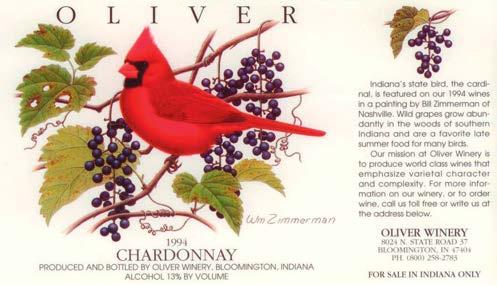
Blanched asparagus
Chef Regina Mehallic , owner, R2GO
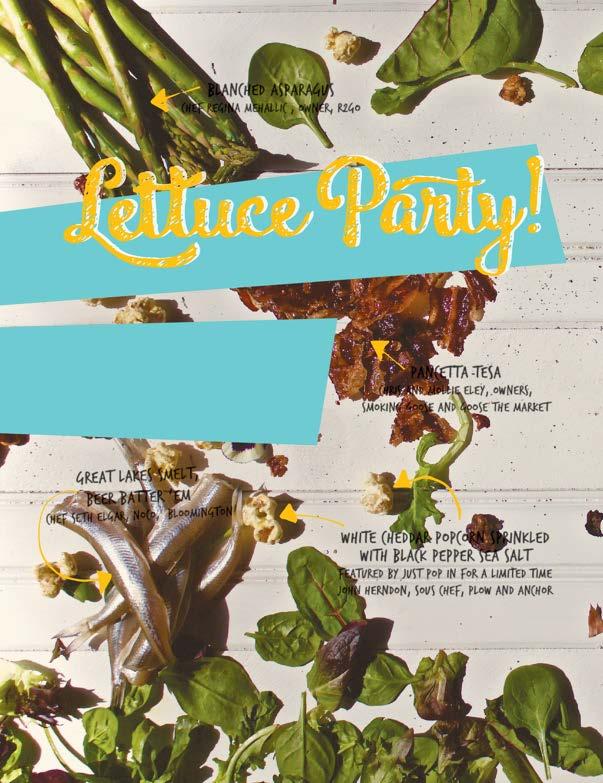
Kick up your salads with these favorite ing redients from our locals!
Great Lakes smelt, beer batter ‘em
Chef Seth Elgar, NOCO, Bloomington
Pancetta Tesa
Chris and Mollie Eley, Owners, Smoking Goose and Goose the Market
White cheddar popcorn sprinkled with black pepper sea salt
Featured by Just Pop In for a limited time
John Herndon, Sous chef, Plow and Anchor

Good cheese
Our pick: Jacobs & Brichford’s Everton Cheese
Brittany Smith, Community Director, Yelp Indy




Coconut bacon
Recipe featured on page 13

Beet noodles
Pansies, eat your flowers
Orange zest
Candied Indiana
black walnuts
Nick Traeger, Sous Chef, Public Greens



Kirsten Serrano, Owner, Restauration Lafayette


SonjaOverhiser, owner, A Couple Cooks
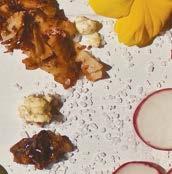

Fresh radishes, sliced thick with grassfed butter and sea salt


Adam Quirk, CEO, Cardinal Spirits
Black pepper and Beet shrub mixed with blood orange oil vinaigrette
Learn to make your own shrubs on page 24

Kendall Lockwood, co-Owner, Ball & Biscuit

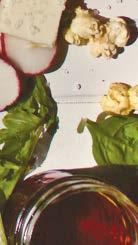
RECIPE AND PHOTOGRAPHY BY A COUPLE COOKS

We’d like to introduce you to Sonja and Alex Overhiser. They are the author, photographer and recipe developer couple behind the food blog A Couple Cooks. Since its inception, A Couple Cooks has garnered an international following for its seasonal, whole food recipes and stunning photography, and have been featured in publications from Huffington Post to Better Homes and Gardens. Widely known for their work as advocates for healthy and sustainable food, Alex and Sonja’s most recent venture is the A Couple Cooks Podcast, which features conversations about food with personalities ranging from local farmers to celebrity chefs. We hope you enjoy their recipes as much as we do!

Serves 4
1 red pepper, chopped into bite-sized pieces
1 red onion, chopped into bite-sized pieces
1 yellow summer squash, chopped into bite-sized pieces
1½ tablespoons olive oil, divided Kosher salt
Fresh ground pepper
¼ teaspoon red pepper flakes
2 tablespoons fresh thyme, chopped
2 tablespoons fresh oregano, chopped
16 large shrimp, cleaned and deveined
1 lemon
Skewers (if using wood skewers, soak for 30 minutes in advance of grilling)
Heat a grill or grill pan to medium-high heat.
Toss pepper, onion and squash with 1 tablespoon olive oil, a sprinkle of kosher salt, fresh ground pepper, a sprinkle of red pepper flakes and half of the fresh herbs.
In separate bowl, toss shrimp with ½ tablespoon olive oil, a sprinkle of kosher salt, fresh ground pepper, ¼ teaspoon red pepper flakes and the other half of the fresh herbs.
Thread shrimp and vegetables onto separate skewers.
Over medium grill, grill the vegetables about 6–7 minutes until tender, turning once. When vegetables are nearly done, grill the shrimp 1–2 minutes on each side, until bright pink.
Serve with lemon wedges. Add freshly squeezed lemon juice prior to serving.
Coconut Bacon
Makes 2 cups
2 cups large, unsweetened coconut flakes (do not substitute shredded coconut)
2 tablespoons olive oil
2½ tablespoons soy sauce
1 tablespoon liquid smoke
1 tablespoon sriracha sauce
Preheat oven to 350°F.
In a medium bowl, gently mix all ingredients until coconut is coated. Line a baking sheet with parchment paper. Spread coconut in a thin, even layer on top. Bake 10–14 minutes, stirring once and rotating the pan halfway through, watching carefully towards the end of the cooking time to ensure it does not burn. Remove when coconut is browned. Allow to cool; it crisps up as it cools.
Serve immediately, or store leftovers in a sealed plastic bag in the freezer (coconut bacon comes back to room temperature after a few minutes at room temperature).

Serves 4 to 6
½ red onion, thinly sliced
2 tablespoons sherry vinegar (or red or white wine vinegar)
2 tablespoons olive oil
1 tablespoon honey
Kosher salt
Pepper, to taste
2 large tomatoes, diced
2 large peaches, diced
1 (15-ounce) can cannellini beans, drained and rinsed (or 1½ cups cooked)
½ cup packed fresh basil leaves, sliced into thin strips
¼ cup feta crumbles
Place onion in a small bowl. Cover in cold water. Squeeze and release the onion slices about 5–6 times. Drain water and repeat squeeze-and-rinse cycle 2 more times. Place the slices back in bowl. Cover with cold water while assembling the salad. In a small bowl, whisk together sherry vinegar, olive oil, honey, 2 pinches kosher salt and several grinds fresh ground pepper.
Drain the onions and squeeze them dry. In a large bowl, gently mix together onions with tomatoes, peaches, beans, basil and vinegar dressing, and a few pinches kosher salt. Sprinkle with crumbled feta cheese. Serve.

Salted Chocolate Pistachio
Creamy Vegan Ice Cream
Makes 1 quart
2 (15-ounce) cans full-fat coconut milk
2 tablespoons cornstarch
⅓ cup agave syrup
⅓ cup coconut sugar
3½ ounces dark chocolate, 70% cocoa (dairy-free for full vegan)
⅓ cup cocoa powder
1½ teaspoons vanilla extract
½ cup pistachios, chopped
½ teaspoon small crystal sea salt
Freeze ice cream maker base overnight.
In a small bowl, mix ½ cup coconut milk with cornstarch. Set aside. Add remainder of coconut milk to a medium pan. Warm coconut milk over medium-low heat for 1–2 minutes, whisking to incorporate the solids Add agave syrup and coconut sugar. Break chocolate into pieces. Add to coconut milk. Stir until thoroughly combined. Whisk in cocoa powder, then cornstarch mixture. Heat until chocolate mixture is thickened, 6–8 minutes (do not boil).
Remove from heat. Stir in vanilla. Strain through a fine-mesh sieve into a 1-gallon sealable plastic bag. If churning immediately, place bag in an ice bath for 30 minutes until cool; if churning the next day, refrigerate 4 hours or overnight (mixture should be as cold as possible before churning).
Churn mixture in an ice cream maker until it thickens to the consistency of soft serve, adding chopped pistachios and sea salt crystals as mixture churns.
Eat immediately for a soft serve consistency. For a hard ice cream texture, freeze using the following instructions: Press a piece of parchment or wax paper into a sealable container, then scrape ice cream into container using a spatula, making sure to scrape in the bits frozen to the edges of the ice cream maker base. Freeze 4 hours.





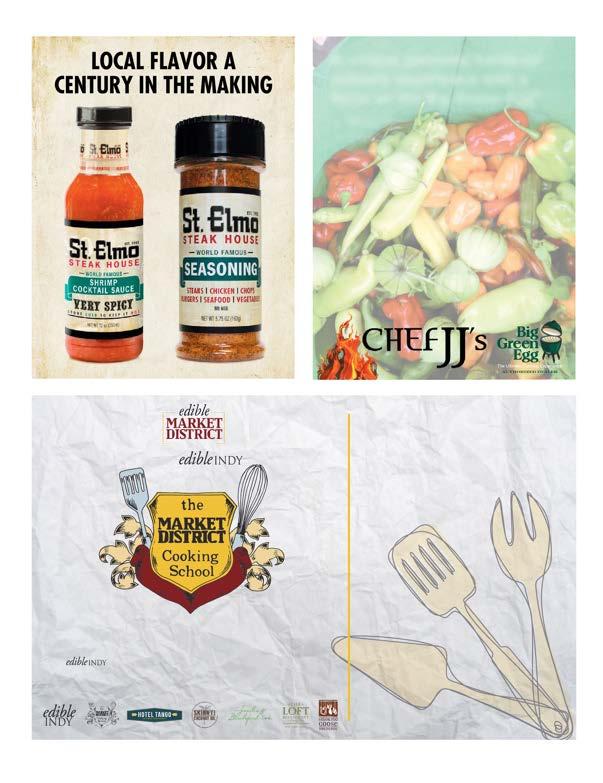
June 14, 2016
Making classic cocktails, shrubs and syrups with Hotel Tango Distillery
Featuring: Megan Stewart, Craft Cocktail Creator at Hotel Tango Artisan Distillery
August 2, 2016
Making sweet and savory grain bowls with an understanding of the grains
Featuring: Skinny Coconut Oil and Traders Point Creamery
September 27, 2016
Making homemade pasta...gnocchi, ravioli and more!
Featuring: Red Gold and LocalFolks Food
November 8, 2016
Charcuterie for the holidays: Wowing your guests with meats, cheeses and condiments
Featuring: Smoking Goose Meatery, Hotel Tango Artisan Distillery and Jacobs & Brichford Cheese


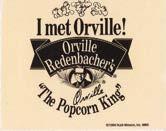






Camp’s
1861 Van Camp’s pork and beans is a Civil War staple
1894 Production of 6 million cans
1933 Acquired by the Stokely family
Stokely-Van Camp headquarters remains in Indianapolis
1967 Stokely-Van Camp starts selling Gatorade
1983 Stokely-Van Camp purchased by Quaker Oats
2001 Quaker Oats purchased by PepsiCo
2016 Gatorade is still produced in Indianapolis






By Jennifer L. Rubenstein •
1938 Founded by Needham King Hurst as a small food commodity distributor
1947 Moves to current location in downtown Indy and packages dry beans in
HamBeens® brand created in the early ’60s and becomes very popular regionally
1986 15 BEAN SOUP® is created and starts to gain national distribution
Hurst’s HamBeens now sold at grocery stores across the country, 15 BEAN SOUP brand is top-selling item in the category

1951 Orville Redenbacher and Charlie Bower form Chesterton Hybrids (seed corn plant)
1970 They launch popping corn under the Orville Redenbacher name
1973 Orville appears in his
Orville Redenbacher has a third of the popcorn market
1976 Redenbacher sold to Hunt-Wesson Foods with multiple buyouts throughout the years
1990 ConAgra purchases Orville Redenbacher


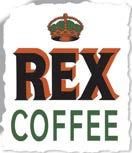







1921–25 owned by Taggart Baking Co.
1925 Purchased by Continental Baking in NYC
1995 Purchased by Interstate Bakeries (Hostess)
2012 Files bankruptcy
2013 Purchased by Flower Foods
2015 Flower Foods acquires organic brand Alpine Valley Bread Co. for $120 million
Wonder Bread is currently in production.
WonderBread.com
N.K. Hurst Co. is still proudly owned and operated by the second, third and fourth generations
2015 ConAgra has 28% of the popcorn market with Orville Redenbacher, Act II and Jiffy Pop


































1


3 Heskerlew Farm 9015 S. Gore Rd. Bloomington 812.327.7391
4 Maple VaLley Farm 3330 W. Maple Grove Rd. Bloomington 812.876.5023 MapleValley.HowardFamilyEnterprise.com
5 Marble HiLl Farm
8101 S. Victor Pike Bloomington 812.824.7877
6 Musgrave Orchard & Co 8820 N. Old SR 37 Bloomington 812.480.7767
7 Schacht FlEece & Meat Farm
8 Stranger’s HiLl ORGANICS

















55 Broad RiPple Farmers Market
1115 Broad Ripple Ave. Indianapolis BroadrippleFarmersMarket.org
SA 8AM–NOON SUMMER MARKET MAY–NOV WINTER MARKET NOV–APR
56 CrOoked CrEek Farmers Market
7003 N. Michigan Rd. Indianapolis 317.257.5388
SU 11:30AM–3PM; JUN–OCT

66 Kokomo downtown farmers’ market
Intersection of Mulberry St. & Washington St. Kokomo 765.210.8235
KokomoFarmersMarket.com TH 5PM–7PM; MAY 7–OCT 15
67 Historic LafayeTte farmers market
5th Street between Main St. and Columbia St. Lafayette 765.742.4041
LafayetteFarmersMarket.com
76 Heritage Farm Suri Alpacas
4175 N. 1200 W. Flora 765.566.3077 OurHeritageFarm.com
Capriole Goat ChEeses
10329
57 cue farm at butler university
Butler West Campus (Bulldog Rd.), South from 52nd St. & Lester St. Indianapolis Legacy.Butler.edu TH 4PM–6PM; JUN–OCT
58 Eskenazi Health Farmers’ Market


720 Eskenazi Ave. (IN FRONT OF THE HOSPITAL) Indianapolis 317.880.3300 TU 11AM–1:30PM; MAY 10–SEP 13
59 Farm to Fork at Normandy Farm 79th & Marsh Rd. Indianapolis FarmToForkMarket.org FR 4PM–7PM; MAY–OCT
60 garfield park farmers market
Corner of Shelby St. & E. Southern Ave. Indianapolis GarfieldParkFarmersMarket.org SA 9AM–12:30PM; MAY–OCT
61 growing places indy

727 N. Oriental St. Indianapolis GrowingPlacesIndy.com TH 4PM-7PM; JUN–SEP
SA 7:30AM–12:30PM; MAY–OCT
68 lebanon CITY market
105 N. Main St. Lebanon 317.776.0205 FIRST FRIDAYS 4—8PM; MAY 6-OCT 7

69 NoblesviLle main strEet Farmers’ Market

839 Conner St. Noblesville 317.776.0205 noblesvillemainst.org SA 8AM–NOON; MAY 7–OCT 15
70 Plainfield Chamber Farmers’ Market
105 S. East St. Plainfield W 4PM–7PM; JUN 1–SEP 14
71 whitestown farmers market
6120 S. 700 E. Whitestown 317.758.5734 SA 10AM–2PM; JUN 11–OCT 15

62 Jewish CoMmunity Center


6701 Hoover Rd. Indianapolis SU 10AM–1:30PM; MAY–OCT

63 the market at hague
7800 N. Hague Rd. Indianapolis 773.505.0851
MarketAtHague.com SA 8AM–12PM; MAY–OCT



72 ZionsviLle Farmers’ Market


Corner of Main St & Hawthorne Zionsville ZionsvilleFarmersMarket.org SA 8AM–11AM; MAY–SEP



64 Original Farmers’ Market at the INDIANAPOLIS City Market

222 E. Market St. Indianapolis 317.634.9266
IndyCM.com W 9:30AM–1:30PM; MAY–OCT
65 slow fOod garden at white river state park
801 W. Washington St. Indianapolis GrowingPlacesIndy.org

Carley


CSA PICK UP SPOT ON W NIGHTS

































he word “preserve” has many meanings: to protect, to keep, to maintain—all words that are associated with a summer harvest. The preservation of seasonal food is essential in creating a pantry full of fresh eats year round, allowing you to sustain the nutritional value while devouring foods picked by your own hands.

















Today’s methods of preserving include canning, freezing, drying, fermenting, pickling, dry salting, curing, sealing, smoking or cellaring meats, herbs, produce and edible greens. Whatever your method, be creative and delight your taste buds with your house-made treats for months to come. Thank you for preserving Indiana!
•3 pounds Indiana blueberries
•1 cup sugar cup Indiana honey
•2 tablespoons fresh-squeezed lemon juice

•2 tablespoons lemon zest cup water cup limoncello
•Basil leaves to taste
•1 package unflavored gelatin













1.In a medium bowl, mix together the blueberries, sugar, honey, lemon juice, zest, water and limoncello. Place the basil leaves in a cheesecloth and tie. Set aside. In a Dutch oven (or a large pot) add the water and blueberry mixture and cook over medium heat until the mixture begins to boil. Place the cheesecloth bundle of basil in the mixture and place temperature on low. Stir occasionally to make sure the mixture does not burn to the pot and that the basil mixture is mashed down into the jam. The more you mash the cheesecloth, the more the basil oils will be released.
2.Continue cooking until the jam begins to thicken, around 30 minutes. Once it begins to thicken, remove from heat. Remove cheesecloth. If you do not like chunky jam, mash the blueberries until the mixture is more smooth. Add in the package of gelatin and the mixture should immediately thicken.


3.While the mixture is cooking, prepare your containers for your preferred preserving process. Jam can be canned in jars or frozen in containers.
Visit FreshPreserving.com for step-by-step instructions on preserving. We recommend using Ball canning jars or freezer containers. Ball is an Indiana company dating back to the late 1800s; the Indiana Historical Society in downtown Indianapolis has an ongoing You Are There exhibit called Communities Can!




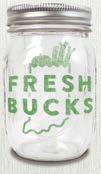
Fresh Bucks is a doubling program for users of SNAP (Supplemental Nutrition Assistance Program) at participating Indianapolis farmers’ markets. The program offers a weekly $20 match to purchase produce, such as fresh fruits, vegetables and herbs. This program encourages participants to connect farmers to new customers while promoting healthy, local, sustainable eating.


Are you a member? Hoosier Farmers Market Association provides education, resources and technical support to Indiana’s farmers’ market community of market managers, vendors, growers, producers and consumers to encourage a vibrant Indiana local food economy. HFMA works with vendors, markets and partners on programs such as Glean Team, Fresh Bucks, SNAP and WIC. For more information on the programs and benefits of Hoosier Farmers Market Association visit HoosierFarmersMarkets.org

This guide is made possible through the partnership of Market District Carmel and This Old Farm. The bold listings within the guide are partners of Edible Indy and we thank them for promoting the local food movement throughout the state.

















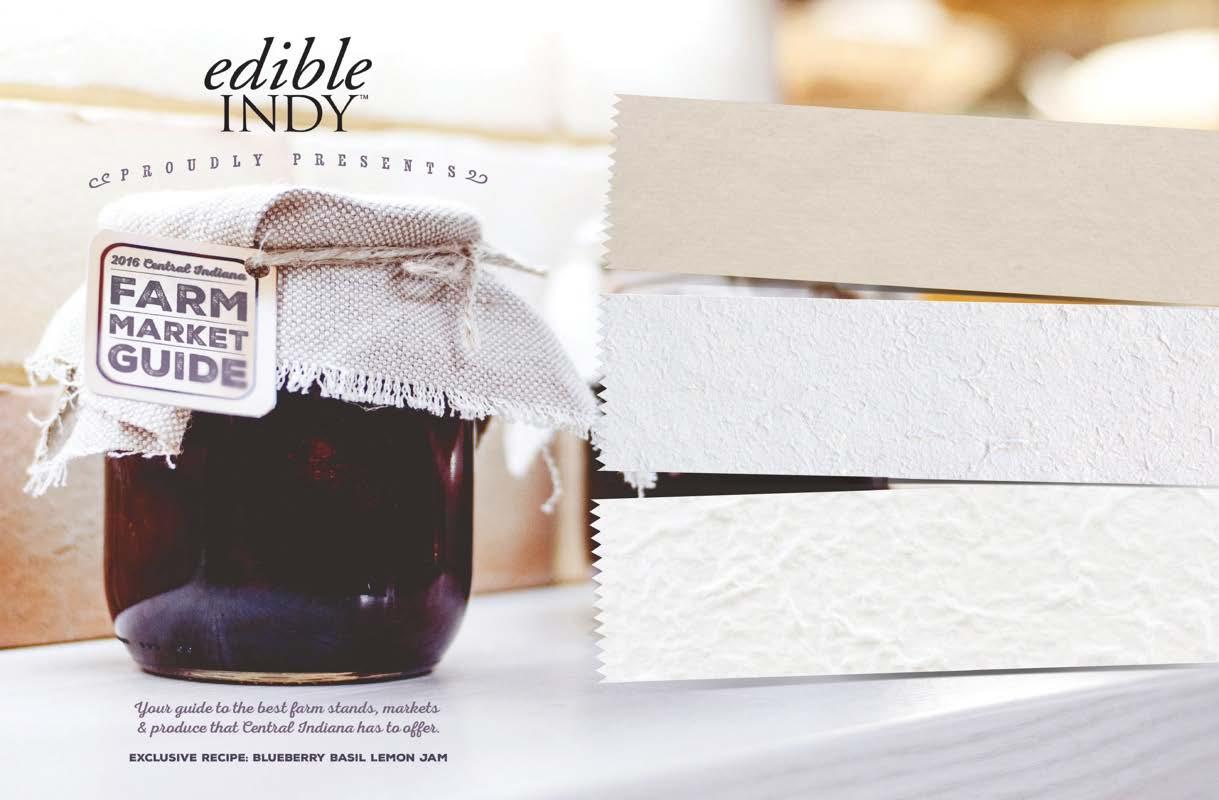
















This Old Farm’s mission is to support the Hoosier family farm by processing, marketing and distributing locally raised, wholesome meat, produce and value- added foods. The true cost of production takes into account the environment, sustainable farm wages and value to the customer. This Old Farm is not just a farm, rather a food hub and custom meat-processing facility located in Colfax. They represent over 100 family farms in a distribution effort to make local foods more readily available.

By bringing together many like-minded producers, they are able to offer a consistent supply to your workplace, restaurant, school/institutional dining service or retail outlet. They have a large variety of produce, meats and other artisanal products to make your local food sourcing a one-stop shopping experience. They have the knowledge and experience at sourcing local products, and look to make the process as turnkey as possible. For more information on the farm or programs offered visit ThisOldFarm.com. This Old Farm processing outlet and retail location is located at 9572 W. CR 650 S., Colfax.















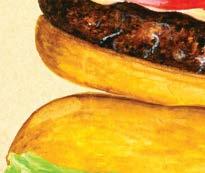


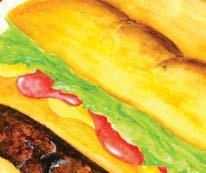



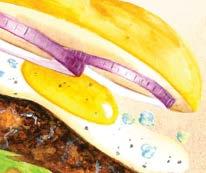

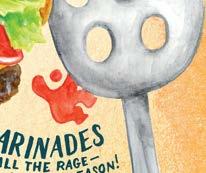

Cover by Justin Guerino


We understand that, for us, grilling is an easy half-year affair (we’ve been known to shovel the deck to get to the grill). But, even by layman’s standards, the cookout culture is definitely in full swing. And, this season, we are all about the seasonings: marinades that take any grillable to new and nouveau heights!
We introduced our new cooking sauces in April and are thrilled with how the marinades are holding up to their grilling promise. Select any for the season’s first cookout and your barbecue will be what’s “in” all summer long.
•Szechuan — Szechuan cuisine is well known for its liberal use of garlic, peanut, sesame and ginger, as is our boldly flavored marinade. Apply generously to shrimp or chicken and grill or bake.
•Korean Style BBQ — This traditional Korean sauce is a delightful combination of soy, sesame, garlic and peppers to add distinct Asian flavor to your table. Try it on pork or beef ribs.
•Greek Inspired Souvlaki — A Greek favorite, our Souvlaki marinade is bursting with oregano, thyme, garlic and lemon to add a fresh and flavorful essence to grilled meats and vegetables.

•Piri Piri — This hot and creamy sauce, also called African Bird’s Eye Chili, is truly unique. Made with chili, garlic and lemon, it adds a fiery kick to meats, tofu, paneer, cauliflower or eggplant — a must for spicy, hot food!
•Sesame Teriyaki — Sweet and savory, this Asian sauce is a smooth blend of soy, sugar, rice vinegar, ginger and garlic that marries well with almost everything, from tofu & vegetables to pork tenderloin. Ultra versatile!
Care to make your own marinade? Chef Crystal Baldwin is all over that! Here are three of her favorites, all purposefully seasoned for particular foods. Focused flavor, indeed! Note: In all cases, discard marinade after use.
Pork or Veggie Marinade
Compliments of Chef Crystal Baldwin
• 3 Tbsp. lemon juice
• 2 tsp. oregano, minced
• 1 tsp. lemon zest
• 1/2 tsp. pepper
• 1/3 cup Market District extra virgin olive oil • 1 tsp. salt
• 2 tsp. garlic, minced
Mix all ingredients in a bowl. Marinate meat for 2-4 hours in a refrigerator. Marinate veggies 20 minutes in the refrigerator. Covers approximately 2-1/2 lbs. poultry, pork or veggies.
Meat Marinade
Compliments of Chef Crystal Baldwin
• 1-1/2 tsp. garlic, minced
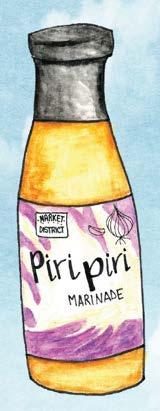
Makes 1-3/4 cups
• 1 Tbsp. rosemary, minced
• 1/2 Tbsp. oregano, minced
• 2 Tbsp. Dijon mustard
• 1/2 cup red wine vinegar
• 1 cup Market District extra virgin olive oil
• 2 tsp. salt
• 1 tsp. pepper


Prep Time 5 min.
Mix all ingredients in a bowl. Marinate meat for 4 hours in the refrigerator. Covers approximately 2 lbs. beef.


Compliments of Chef Crystal Baldwin
• 2 Tbsp. shallot, minced
• 1/4 cup mirin
• 3 Tbsp. lime juice
• 1 tsp. honey
• 1/2 serrano chile, seeded & minced
• 1 tsp. salt
• 3 Tbsp. Market District extra virgin olive oil Makes 1 cup Prep Time 5 min.
Mix all ingredients in a bowl. Marinate fish or veggies (or both) for 20 minutes in the refrigerator. Covers approximately 2-1/2 lbs. fish or veggies.
Professional marinade/flavor injector with measure marks. Designed to dispense marinade evenly and accurately. Needle is nickle plated copper. Measures 8.5 inches.
This unique cutting board, designed by a completely women-run company that uses elements of architecture to improve everyday kitchen essentials, keeps meat resting in its own juices as you prep. The result? Tastier, more tender cuts of meat. Crafted of handsome rubberwood, it is much gentler on cutlery than plastic surfaces, keeping your knives sharper, longer. Plus, the patented gripper base provides a safe, non-slip surface when slicing and carving.
Convenient, Full-Flavored, Clean-Ingredient Grilling

Every day, our Chefs cut and prepare a variety of marinated meats available in our Fresh Meat Department, so that grilling a fabulously flavorful entrée is as easy as stopping by the store on your way home. No prep, no waiting, no worries. All of our marinades are made with simple, pure ingredients and no artificial flavors or preservatives — all the pleasures of complex flavors crafted with clean ingredients. Kind of like the way you would make them at home, except you don’t have to!
• Caribbean Mango — This marinade is made from real mango, cane sugar, sweet red peppers, Dijon mustard and pepper sauce for a tropical blend of sweet and spicy that is outstanding on our chicken breasts, satays and kabobs.

• Garlic Teriyaki — A classic blend of soy sauce, cane sugar, fresh garlic, ginger and lemon, this marinade adds an Asian touch to our petite sirloin, beef & chicken kabobs, pork tenderloin and chicken breasts.
• Honey Buffalo — A favorite all around, this marinade is super flavored with pepper sauce, tomato purée, honey, butter, tamari, Worcestershire sauce and garlic. We put it on chicken drumsticks, thighs, wings or kabobs, as well as boneless chicken breasts for your immediate grilling delight!
• Sweet Bourbon — A decadent blend of bourbon, soy sauce, cane sugar, molasses, garlic and onion make this southern marinade taste awesome on almost anything grilled, but we sell it on beef or chicken kabobs, beef satays, chicken breasts, Delmonico or strip steaks, London broil, petite sirloin and pork tenderloin — try them all!
• Sweet Thai Chili — Sweet and hot with a touch of Thai, this marinade is made from Thai chili purée, water, cane sugar, distilled vinegar, garlic, red bell pepper, sea salt and paprika extract. You’ll find it on our chicken breasts and kabobs, as well as pork tenderloin.





Chef Crystal Baldwin has more than 25 years experience catering and as a personal chef, cooking for high-end restaurants, corporate facilities and higher education. A native Pittsburgher, she graduated from Pennsylvania Culinary Institute, but her years at Penn State studying nutrition science left her an avid Nittany Lions fan. Today, Crystal is committed to feeding your excitement for cooking and creating a dynamic environment to learn and experience new foods and flavors.



Really, what could be simpler ? Made from 100% Cert i fied Angus Beef ® or local, farmhouse ground beef (always the best), our 3/4-pound burgers are made in-house daily ! Though we have a wide select ion, our newest hott ies include :
• Sriracha — One sassy number — mixed with red j alapeños, soy sauce, r ice w ine vinegar, miso, spices and garlic for a burger w ith a little bite !
• Korean BBQ — Barbecue with an Asi an touch featur ing a blend of soy sauce, pure cane sugar, pear puré e, sake, garlic, ginger, spices and lemon juice .
• Bold & Smoky — A well-balanced mix of cane sugar, tomato paste, sea salt, spices, pineapple juice concentrate, Worcestershire, natural smoke flavor and garlic for a burger with a little brass
We’ve also got classics like Bacon Cheddar and Mushroom Swiss — mix and match and you’ve got something for everyone ! And, don’t forget our made-from-scratch Honey Butter Buns fresh in our Bakery Now, THAT ’ S a burger !
ass cs Chedda r And, forget Butter Bu ever yone , g






Stupendous Salmon Burgers
Another Way to Sea Burgers
Fishing for something completely different ? Get hooked on our stupendously tasty salmon burgers Juicy, tender, w ildly moist and full of flavor, they come prepared, deliciously mixed w ith excit ing ingredients to bring out the essence of the salmon’ s rich, meaty taste Find them in our Seafood Department pract ically leaping from the lines in these favored varieties :
• Spinach & Feta — Fresh, sk inless salmon, green onions, OLD BAY® seasoning, mayonnaise, spinach, Feta & panko bread crumbs .

• Garden Vegetable — Fresh, sk inless salmon, an array of garden vegetables, light mayonnaise & panko bread crumbs .

Alaska Copper River Salmon, Limited Time Only!







We’re pleased to announce that world famous Alaska Copper River salmon — iced and jet-shipped within hours of being caught for the absolute freshest flavor and texture — will be available in our Fresh Seafood Department throughout the month. Exclusive, unforgettably rich and sumptuous, our fresh Alaska Copper River Salmon awaits your grilling pleasure !

OK, we’re talking minus the liqueur, but we also believe in improvisation, so feel free! Regardless, we love fresh fruit on the grill, especially Chef Ben’s Grilled Bananas Foster — as pretty on the plate as it is pleasing to the palate!
Grilled Bananas Foster
Compliments of Chef Ben D’Amico
• 1/4 tsp. cinnamon, ground
• 1 Tbsp. granulated sugar or raw cane sugar
• 1 banana, peeled, cut in half lengthwise
• Cooking spray
• 1/2 cup Market District Vanilla Bean ice cream
• 4 vanilla wafers, rough chopped
Grilling:
1. Preheat grill or grill pan.
2. Mix cinnamon and sugar in a small, flat bowl.
3. Dip banana in cinnamon-sugar mixture.
4. Spray banana with cooking spray prior to setting on the grill.
5. Place banana sliced-side down onto grill or grill pan for 2-3 minutes.
6. Remove from grill and set aside for plating.
•1 Tbsp. pecans, chopped
•5 dried banana chips
•1/2 Tbsp. honey, drizzled
•1/2 Tbsp. caramel sauce, drizzled
Assembly:
1. Crisscross banana halves in center of plate.
2. Place ice cream on top intersection of bananas.

3. Sprinkle with chopped vanilla wafers, pecans and banana chips for crunch.
4. Finish by drizzling plate with honey and caramel sauce.


Grilling Fruit is Easy! First, always cut your fruit in similar sized pieces. Less dense fruit like bananas and watermelon should be grilled on medium to high heat. More dense fruit like pineapple grills better on medium for longer. It will only take a minute for light fruit like strawberries (maybe put these on a skewer) and up to five for peaches, so watch closely. Make sure fruit retains its texture. Then, drizzle with Chef Crystal’s Grilled Fruit Topping and use atop ice cream!
Compliments of Chef Crystal Baldwin
• 1/4 cup honey
• 1 tsp. thyme, minced
• 1/8 tsp. black pepper, freshly ground
• 1 Tbsp. white balsamic vinegar Makes 1/3 cup Prep Time 5 min.
Mix all ingredients in a bowl. Drizzle the sauce over hot grilled fruit, like peaches, pineapple or strawberries! Covers approximately 2 lbs. fruit.





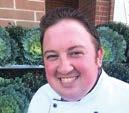
Who’s Chef Ben D’Amico?
Chef Ben earned an Associates Degree in Culinary Arts and a Bachelor’s Degree in Culinary Nutrition from Johnson & Wales University. As Associate Product Development Chef for Market District, he is our go-to guy for new recipes, menus and products. Ben loves working with fresh, seasonal ingredients and adding creative twists to classic dishes.


Yeah, it’s been done, but why aren’t more of us doing it? Maybe because grilling veggies is just a little intimidating? They cook fast and you have to keep an eye on them, but when you do it right, grilling brings out rich, sweet caramelized veggie flavors that are hard to beat. Follow these tips and in no time at all, grilling veggies will be as basic as the burger — and better for you!
Thicker, denser veggies, like potatoes, yams, beets and carrots will take longer to grill, but you don’t want to keep them over high heat because they will char on the outside but remain raw on the inside. Solution? Spread evenly in a veggie basket coated with cooking spray, sear over high heat, flip, sear again and then move to a cooler part of the grill. You can also par boil and then grill, just for the added smoky flavor and color.
More delicate veggies, like lettuces, radicchio, green beans, tomatoes, etc., will cook fast — a minute or two. Keep these away from high heat in all cases and keep a close watch. Aim for cooking them through with a couple of grill lines for ambiance.


Before they hit the grill, toss or spray your veggies with a light coating of Market District extra virgin olive oil to keep them from sticking. Tossing in olive oil also allows any seasonings to stick better. But be careful, too much oil can cause dripping and flare-ups.



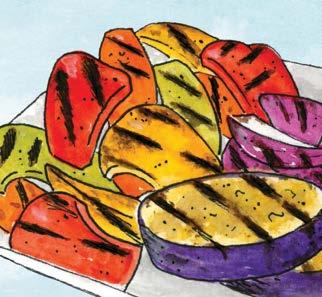

Clearly, the smaller/thinner you cut your veggies, the faster they will cook. That said, make sure the thickness is consistent, and if you want crispiness, slice thin. This also allows for more surface area, so veggies like onions and eggplant will be done in no time.
This is kind of a no-brainer. If the veggies are so small they will fall through the grate, (like cherry tomatoes) put them on a skewer.




th fo you open a to check doneness , be careful of steam . p g s a long w ay ! erce


If you are unable to attend to your veggies with fierce method for dense, root vegetables. Simply spray the foil with nonstick spray, fill with one layer of veggies, fold and crimp. Cover the grill and cook until the vegetables are tender, about 12 to 15 minutes. When you open a packet




he foil old and s are





•Harold Import Company Skewers — A kabob classic, specially designed with a square profile to hold food in place and prevent it from spinning while on the grill. Plus, the pointed tip and ring-top handle makes loading and removing foods easy. Reusable, durable, plus food, oven, flame and dishwasher safe, it includes four skewers.
•Charcoal Companion ® Expandable Grilling Basket — This stainless steel basket has a unique flexible mesh that accommodates everything from fish fillets to whole zucchini. Food is locked into the basket so it can be turned all at once without losing a bite.
Got your notes and your gear? Now try Chef Ben’s Grilled Zucchini & Bell Pepper Fattoush! Why not cook your whole darn dinner on the grill?!
Compliments of Chef Ben D’Amico
• 1-1/2 lbs. fresh zucchini, cut into 4 long pieces
• 1 red bell pepper, seeded, cut in half
• 1 yellow bell pepper, seeded, cut in half
• 2 Tbsp. Market District extra virgin olive oil
• 1/2 tsp. kosher salt
• 1/4 tsp. black pepper, fresh ground
• 1 cup cucumber, seeded, diced
• 3/4 cup grape tomatoes
• 1/8 cup green onion, sliced thin
1. Preheat grill to medium-high.

• 1/4 cup kalamata olives, pitted
• 2 Tbsp. fresh mint, minced
• 2 Tbsp. fresh cilantro, minced
• 1-1/2 Tbsp. lemon juice, fresh squeezed
• 1/8 tsp. ground cumin
• 1/2 tsp. kosher salt
• 1/4 tsp. black pepper, fresh ground
• 3/4 cup Feta cheese, crumbled
• Pita, optional
2. Brush the cut zucchini and bell peppers with olive oil, then season with salt and pepper, and place in grill basket on the grill.
3. Grill the vegetables for 4-5 minutes and flip the basket until you have bold char marks and the vegetables start to become soft.
4. Set aside and allow to cool.
5. Dice peppers and zucchini into medium-sized pieces.
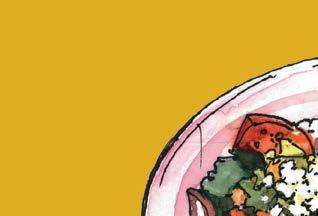
6. In a large bowl, combine the diced grilled vegetables, cucumber, tomatoes, green onion, olives, mint and cilantro.
6. large combine vegetables, tomatoes, olives, cilantro.
7. In another small bowl, combine the lemon juice, cumin, salt, pepper and olive oil and mix well.
7. In anot her small bowl, combine t he juice, cumin, pepper olive oil and mix well.
8 Toss all of the vegetables with the dressing and let sit for 30 minutes.
9. G arnish with crumbled Feta cheese and serve with pita





Grilling cheeses are all fine and good — we’ll go to our grave loving Halloumi — but this month, Rebecca is interested in cheeses with a fine melting point that add textural, tasty delight to anything grilled — cheese at its cheesiest!
We start with Uniekaas Smoked Gouda, a Dutch cheese named after the city of Gouda in the Netherlands. Regular Gouda (“How-da”) is one of the most popular cheeses in the world, accounting for 50 to 60% of the world’s cheese consumption. This version is smoked in ancient brick ovens over fl aming hickory chip embers for its unique smoky fl avor. It is a hard cheese with an edible, brown rind and a creamy, yellow interior, outstanding on burgers and grilled sausages. It is also a natural with beers. Serve with a Bock, Brown Ale, Lager, Pale Ale, Porter or Stout and the fl avors are exponentially enhanced.

Another unforgettable cheese when accenting grilled foods is Rogue Creamery Caveman Blue (that is, if you don’t eat it all while you’re waiting for your food to cook). A rich, complex blue that is deliciously sweet and fruity with slight vanilla tones and a texture of butter, it is cave-aged a minimum of 6 months.
During its maturation, cow’s milk and blue cultures are transformed into a golden-hued paste which tastes of sweet, fresh buttermilk with nuances of beef and bacon, tropical fruit, grass and hay (seriously, ask anyone). And, though its name and mold-riddled exterior imply a lack of refinement, these wheels are anything but. The rugged, natural rind allows the Caveman to release moisture which develops a thick, buttery texture. One bite and you’re all about the neanderthal just waiting for the fl ame!




Chef Ben uses it in a lovely recipe for a Grilled Romaine Salad (next page). Try it and you’ll be singing the blues, too!






With multi-cultural culinary tastes and flair for both local and fine foods, Rebecca makes eating well in the company of family and friends an appetizing priority. Her über taste buds and diverse palate position her as a trendsetting Cheesemonger on our Market District Team. Cheers ... ¡A la vida buena!



Compliments of Chef Ben D’Amico
• 2 romaine hearts, cut in half
• Cooking spray
• 8 oz. Caveman blue cheese, cut into 1-inch slices
• 2 oz. shallots, thinly shaved
• 4 oz. Olli Salumeria Calabrese Spicy Salame, shaved
1. Preheat grill or grill pan.
• 1/2 tsp. black pepper, fresh ground
• 1/4 cup roasted kalamata olives (recipe below)
• 2 Tbsp. pistachios, rough chopped
• 2 Tbsp. Market District extra virgin olive oil
• 2 Tbsp. Market District balsamic glaze
2. Spray the cut side of the romaine heart with cooking spray and place on hot grill.
3. Grill romaine for 2-4 minutes until char marks appear.
4. Cut grilled romaine halves in half lengthwise and place on plates.
5. Top romaine with a slice of blue cheese, then shallots, a few roasted olives and 1 oz. of shaved salame.
6. Garnish with pepper and pistachios, then drizzle with oil and balsamic glaze.
Chef’s note: Olives may be roasted while grilling romaine.
Nutritional Information (Per serving): Calories 470, Fat 36g, Sat. Fat 15g, Trans Fat 0g, Cholesterol 65mg, Sodium 1270mg, Tota l Carbohydrate 15g, Fiber 5g, Sugars 7g,
Nutritional values are based on data from the USDA National Nutrient Database for Standard
to suppliers, regional and seasonal differences, or rounding.

Compliments of Chef Ben D’Amico
• 15 oz. kalamata olives from our Olive Bar
• 1 Tbsp. Market District extra virgin olive oil
• 1/2 tsp. kosher salt
• 1/2 tsp. black pepper, fresh ground
1. Preheat oven to 350°F.
2. Drain olives and toss with olive oil, salt and pepper.

Actual nutritional values
vary due to preparation techniques, variations
3. Place olives on a foil-lined baking tray and roast for 10-15 minutes until slightly shrunken and wrinkled.
Information (Per
are based on data from the
Of Italian legacy but Virginia residency, Olli Salumeria makes artisanal, slow-cured meats based on original, 160-year-old family recipes handed down over four generations. All of their salame is made with pork from pigs raised on family-owned sustainable farms. And not just any pigs. They go to great lengths to obtain the best in the country: heritage breed pigs that are humanely pasture-raised and fed all-vegetarian feeds (antibiotic-free and never any animal by-products).
They also use the most gentle curing process to preserve the superior quality of their pork, hand-rubbing the meat with carefully mixed spice blends.
We carry their 6 oz. Calabrese Spicy Salame, as well as their more mild Genoa Salame that is pre-sliced for your snacking convenience — also handy when making pizza or a quick antipasti platter.






Last minute barbecue? Cookout on the fly? Get-together on the deck? Stop by our Prepared Foods Department to find these exciting, new, flavor-packed side salads (or entrées, depending on what kind of party guest you are) to round out your menu with a little foodie flair.
•Greek Farmer’s Salad — A simple salad of fresh cucumbers, onions and tomatoes tossed in a vinaigrette dressing and garnished with Feta cheese.
•Italian Tuna & Kale Salad — Savory flaked tuna tossed with kalamata olives, roasted red peppers, red onion and kale in a tangy vinaigrette (ok, this kind of is a meal).
•Brussels Sprouts with Apples & Almonds — Shaved Brussels sprouts tossed with sliced apples and almonds in a vinegary slaw dressing.
But wait! That’s not all! Our Chefs are always changing things up. This summer, we’re bringing you some intentional entrée salads, made solely to serve center-plate pleasure. Pick up on your way to work for lunch, or on your way home for supper — add a bun and dinner’s done!

NEW! Grab & Go Salads
Grilled Chicken, Walnut & Goat Cheese Salad with Grapes & Gorgonzola Vinaigrette
Grilled chicken on a bed of romaine
and spring mix greens, garnished wit h red grapes, walnuts, sunflower seeds and tart, earthy, crumbled goat cheese.
See back page for a $1 OFF coupon!
Chef’s Antipasto Salad with Sweet Basil Dressing
Sliced turkey, salami, ham and Swiss cheese on a bed of romaine and baby kale, garnished with tomatoes,
b aby k ale, wit h tomatoes, cucumber, k al amata olives and h ard - boiled eg g.
Japanese-Style Spicy Steak Salad with Soy Ginger Dressing
Sliced sirloin on a bed of romaine and baby kale, topped with red cabbage, tear drop peppers and rice noodles, garnished with wasabi peas, sesame

tear peppers rice noodles, wit h wasabi pe as, sesame seed s and fresh cilant ro


But more importantly, it’s an experience rich with family tradition, memories, hard work and delicious satisfaction. Yup, you can taste all that in one bite of McClure’s family pickle recipe.
Founded in 2006 by brothers Bob & Joe McClure using their great-grandmother Lala’s recipe, McClure’s Pickles has stayed true to its values of community, honesty and simple, good food for a decade.
“I was a commercial actor and my brother had a PhD in Physiology,” explains Bob, who now serves as CEO of the company. “We were both looking for something that would allow us to do what we love. Our great-grandma’s pickle recipe was a no-brainer.”
With a couple hundred dollars and six ingredients — fresh cucumbers, vinegar, water, salt, dill and garlic — Bob and Joe made their first commercial batch and sold them door-to-door. Soon they were on local retailer shelves and within a year, reviewed in The New York Times.
“That experience is uniquely simple — the joy of being together — and very work-ethic Detroit. We put that joy in every jar.”
“Of course we are selling great pickles, but really, it’s the total food experience that matters to us. When we were young, our family, friends and neighbors would gather in our kitchen on a hot summer day and spend it pickling — sharing stories, laughing, working and creating food that would last much like the memories. That experience is uniquely simple — the joy of being together — and very work-ethic Detroit. We put that joy in every jar.”
What else goes in the jar? The McClures use as many local ingredients as possible and always fresh — fresh cucumbers, fresh dill, fresh garlic — all traceable. Every jar is hand-packed by one of their 30 team members and today they (the pickles) can be found in every state — even Alaska!
“Fermentation, canning and jarring reach across cultures; it’s a part of everyone’s culinary history prior to refrigeration,” says Bob. “And the sharing of food also crosses cultures. You don’t need to know someone’s language to enjoy their cuisine. We wanted to be a part of that exchange. We wanted to connect to something meaningful — our heritage. So, though fermented foods are certainly on trend now, we are all about, if you’ll pardon the pun, preserving tradition.”
Find McClure’s Garlic Dill and Spicy Dill Spears in our Condiment Aisle — on sale this month!



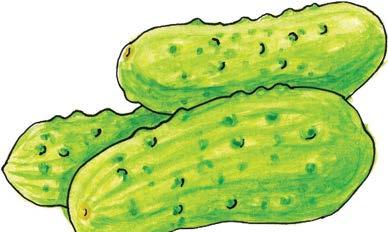




June is known for its summer gatherings: graduations, showers, big wins at the ballpark. And, that’s where our treat platters come in! You really can’t go wrong. And if you do, it has nothing to do with dessert!
Classic Cupcakes — The Venerated Cake To-Go
People aren’t always sitting down at parties, so cupcakes are the ultimate way to have your cake and eat it too — and get to the next party! Order in your party colors iced with buttercream and sprinkles if you like!
Large, 32 ct., $32.99; Small, 16 ct., $16.99
Gobs — The Cool Kids’ Cake
These small, moist cake mounds come in an assortment of our most popular flavors like yellow, chocolate and red velvet, all sandwiched with our famous buttercream or fudge icing!
Large, 48 ct., $26.99; Small, 24 ct., $13.99

All-Butter Cookies — ‘Cause It’s Better with Butter


Our selection of cookies made with real butter includes beloved standards like chocolate chip, sugar, oatmeal raisin and peanut butter, but then there’s the white chocolate macadamia coconut, trail mix and double chocolate. It’s a pretty
Large, 48 ct.,


See back page for a $1 OFF coupon!

Brownies — Chocolate for All!
Our brownies are made with European-style Dutch cocoa and real butter for a deep, fudgy taste and texture that’s hard to resist. Then, we top them with fudge and peanut butter icing, so there’s no way you can!

Large, 32 ct., $35.99; Small, 16 ct., $18.99
Assorted Cookie Platter — Basic Bests
This is our collection of traditional cookies that includes everyone’s favorites. Order up because there are never any left — and that would be sad.
Large, 96 ct., $42.99; Medium, 60 ct., $25.99; Small, 30 ct., $14.99





We’re Talking Taffy!
It’s summer with beaches and boardwalks just around the bend, and we’re singing the praises of old-fashioned salt water taffy — pulled and cut, sweet and chewy — you’ll find it available in all your favorite fruity, rich and tangy flavors, just $3.99 lb. in bulk — mix and match. And don’t forget to use the coupon on the back for $1 OFF per pound!





Popcorn of the Month — Cookies & Cream
We’re serious, and it’s made with chunks of real Oreo ® cookies — the perfect mix of savory and sweet — and crunchy. You don’t even need a movie!

Fudge of the Month — Watermelon
Tastes just like the real thing only sweeter! A fun summer treat that takes the season’s traditions— picnics, boardwalks, flea markets — and packs them into each yummy bite. Plus, Buy 2, Get 1 Free!

Effortless yet edgy, playful but polished, and sharply tailored for today’s sophisticated bad boy, Billy Jealousy is geared toward men who know how to look good. We’re guessing that’s your Dad!
Scientifically designed to help cleanse and promote the health, texture and tone of your skin, each formulation contains 5 to 20 different key ingredients combined to create a chemical reaction that directly enhances and protects your appearance.
Plus, for every product they sell, Billy Jealousy donates a portion of the proceeds to key organizations, such as Big Brothers Big Sisters and Green Corps, that share their interest in supporting the arts, the environment and human needs!


Summer is here and face it, in this day and age, everybody can use a little protection from the sun. With rates of skin cancer doubling, Combat Lines Face Moisturizer SPF 30 contains the latest in sun technologies for broad spectrum UVA/UVB protection, incorporating AcquaCell and Aesthigel technologies to provide superior hydration while helping reduce the appearance of fine lines and wrinkles, $38.
This set includes a hydrating beard wash with aloe and soy protein, an extra-firm, boar bristle brush and a styling beard control product with jojoba oil. Refine the rugged! $25.
Esquire2014 Grooming Awards Winner!
For the traveling Dad, this unique shave system features the following in 3 oz., airline-approved bottles:
• Hot Towel Pre-Shave Treatment — Heats, softens & conditions beard for a smoother, more comfortable shave
• Hydroplane Shave Cream — Protects skin while yielding extraordinary razor glide
• Shaved Ice After-Shave Balm — Cools, soothes and hydrates skin while blocking pain Plus, you get a clear zipper bag to conveniently store it all, $40.




Whether you’re hosting 5 or 500, our Caterers can help you plan a delightful summer party — and make it that much easier! From classic fried chicken, potato salad and sandwich rings to artisan cheeses, charcuterie platters and cupcakes in party colors, we’ll make your celebration a breeze! Below is a selection of our NEW Graduation Packages that can be ordered for any graduation or summer party. Simply plan your order at catering.marketdistrict.com.
Graduate Package | $9.99 per person
• Traditional Vegetable Crudité with choice of Ranch or Bleu Cheese Dressing
• Giant Eagle Chips & Pretzels
• Choice of (1) Prepared or Tossed Salad
• Market District Dinner Rolls & Butter
• Fried & Roasted Chicken
• Choice of (2) Side Dishes
• Assorted Butter-Made Cookies

Honors Package | $14.99 per person
• Traditional Vegetable Crudité with choice of Ranch or Bleu Cheese Dressing
• Fresh-Cut Fruit Platter
• Giant Eagle Chips & Pretzels
• Choice of (2) Prepared or Tossed Salads
• Market District Dinner Rolls & Butter
• Fried & Roasted Chicken
• Choice of (1) Additional Entrées
• Choice of (2) Side Dishes
• Assorted Butter-Made Cookies
First in Class | $19.99 per person
• Traditional Vegetable Crudité with choice of Ranch or Bleu Cheese Dressing
• Fresh-Cut Fruit Platter
• Giant Eagle Chips & Pretzels
• Choice of (3) Prepared or Tossed Salads
• Market District Dinner Rolls & Butter
• Fried & Roasted Chicken
• Choice of (2) Additional Entrées
• Choice of (3) Side Dishes
• Assorted Butter-Made Cookies
For complete Salad, Side & Entrée lists, please call our Caterers. They can help you with beverages, flowers, balloons & servingware, too!
Let Them Eat Cake!
Don’t forget to order your custom sheet cake! We have school colors, 2016 decorations and the cake size to fit your guest list!
Pennsylvania
412.490.5826 Robinson
412.621.2453 Shadyside
412.347.0441 South Hills
724.934.0310 Twp. of Pine
412.449.0049 Waterworks

317.569.0378 Carmel
Ohio
614.717.9436 Dublin
614.294.2373 Grandview Yard
330.899.9038 Green
614.538.0783 Kingsdale
330.849.2467 Portage Crossing
440.519.1381 Solon
440.238.6401 Strongsville





Red, Rich, Rainforest Roses!
Think green — not the roses, but the source. Imported by Elite Flower, one of the most advanced rose breeders in South America, our rainforest roses are certified Florverde ® and Veriflora, which evidences a commitment to sound agricultural practices and social awareness. In fact, Elite Flower plants, raises and harvests all of its roses in ways that respect the environment and the well-being of its employees and customers, proving conscientiousness is, indeed, a beautiful thing. Available in both single stems and bouquets.
Flower s in



It’s Easy with Our NEW Health & Wellness Tags!
Look for these tags that call out up to three attributes on qualifying products, so you know good foods to choose. Questions? Call our Registered Dietitians: 1.877.289.2588 Mon. – Fri., 10 a.m. – 8 p.m.

Donut Fridays!
Get a Dozen Donuts for just $5 at any of our Bakeries! A “hole” lot to share!





Come learn tips, tricks and more from organic authorities, columnists and co-hosts of KDKA Radio’s The Organic Gardeners, Jessica Walliser and Doug Oster!
June 12
South Hills, 9:30 a.m. • Waterworks, 12:00 p.m. Township of Pine, 2:30 p.m.

Check out your store’s Demo Kitchen schedule and then stop by to see what our Chefs are preparing and sharing! • Original Recipes & Tips • New Foods & Tricks $5
from







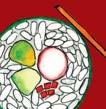





















































Download our mobile menu, select your favorite Market District location and we’ll connect the app with your in-store experience. Enjoy simplicity and savings, including:
Scan it when you shop to save even more!
Don’t miss any of our in-store savings! Browse our Weekly Sales & Specials, clip eOffers ® (digital coupons) and check out the eAdvantage™ Offer of the Week!
Scan a barcode or type in just a few characters to start adding products to your list. We’ll organize it based on your store’s aisles.
Add your latest purchases to your virtual cupboard and remove items as you use them to keep tabs on inventory!




1943–44 Choc-Ola® is created, bottled and sold by Harry Norrington Sr.
Located at 2301 Churchman Ave., Indianapolis
Distributed in Indiana, Illinois, Kentucky, Ohio and Michigan
1970s Advertised during local Indianapolis television show
“Cowboy Bob’s Corral”
1977 Sold to Moxie Industries of Atlanta
Moxie continued to operate out of Indianapolis until 1982
1978 Pete Rose partners with Choc-Ola on the short-lived beverage “Pete”
1985 Yoo-hoo purchases Choc-Ola
2003 Mott’s acquires Choc-Ola
2009 Choc-Ola trademark expires and is not renewed
2010 Trademark acquired by Dan Iaria of Choc-Ola Corporation and Rock-Cola 50’s Cafe, Indianapolis
2011 Prairie Farms in Anderson produces half-gallon jugs and individual bottles
2012 Dairy Farmers of packages shelf-stable cans
2016 Choc-Ola is available in cans and online
Choc-Ola.com

1879 Herman Hulman begins spice grinding and coffee roasting
1885 Hulman & Co. sells
Rex Coffee is sold from Chicago to Louisville and Cincinnati to St. Louis
Marketed under the names: Rex, Farmers Pride, Dauntless, Crystal and Delicious Sips
1968 Rex Coffee ceases coffee production
2009 Historical materials are found and lead to the coffee’s re-creation
Rex Roasting Co. currently produces Rex Original Blend and Farmers Pride coffee blends at the corporate Corporation
RexRoasting.com
Established in 2003 by Dr. Fritz Kunz and Jane Elder Kunz
First modern organic dairy and grass-fed animal farm in Indiana
2003 First bottle of organic milk rolls off the line
2004 and chocolate milk are added
2005 cheese, Fleur de la Terre, is released
2015 The American Cheese Society chooses their whole milk yogurt as “America’s Best Yogurt”
TPC has won more than 15 outstanding awards and has the Snail of Approval award from
Slow Food International TradersPointCreamery com
1837 Chauncey Warren and Demas Deming Sr. start the Terre Haute Brewing Co.
By 1900, THBC is the seventh-largest beer producer
1904 Champagne Velvet (CV) appears as the
1907 “Champagne Velvet is the beer for your home” ad helps to increase sales of the beer
1935 CV starts using the motto “The Beer with the Million Dollar Flavor”
1935 THBC insures the CV formula for one million dollars
1958 Atlantic Brewing Co. buys the assets to THBC, stops making CV
1990s Mike Rowe buys CV memorabilia, including the long-lost original formula for the beer
1999 Rowe purchases the CV trademark and relaunches the CV beer
2008 Production ceases and Rowe strikes a deal to lease his brewery to Broad Ripple’s Brugge Brasserie
2012 Upland Brewing Co. purchases the rights to CV from Rowe
2013 Upland Brewing Co. revives the beer to mark the company’s 15th anniversary
2016 Upland releases new packaging based on the original packaging from the 1940s


BY RACHEL D. RUSSELL

a sweet, brown drink flavored with roots and herbs and that contains bubbles.
Yes, Merriam-Webster has a definition for root beer, but perhaps your definition is a little more personal.
Maybe you remember the first time you went to an old-timey mom-and-pop root beer and chili dog stand with your parents or grandparents, or with a friend of yours and their parents who lived in a small town lucky enough to have such a place.
You ordered your food, but more importantly, you ordered root beer. And when it came, you reached for that frost-covered, thick-handled mug (sometimes suspended from the car window with some kind of gravity magic) and took the first pull from that dark and sweet-smelling beverage—the scant surface layer of ice coming in with your first gulp. Your taste receptors told your brain: This is the good stuff.
And somewhere in between apple pie and hamburgers, you’ll find this good stuff sitting on the list of America’s food icons.
But first, a little history never hurt anyone.
Root beer was at one time known as “small beers.” (There’s a rumor that perhaps even Shakespeare made note of them in his iambic pentameter.) All that ado aside, “small beers” appear to have been manufactured during Colonial times from a huge variety of herbs, bark and roots. Then, carbonation would be added and root beer was officially made. There’s no set recipe and there’s even variety from one batch to the next when using the same recipe. You’ll find much mention of Charles Hires, a Philadelphia pharmacist, as the father and inventor of root beer around 1876, but the Library of Congress contains books full of root beer recipes dating up to 20 years before he fashioned and sold his own variety.
Some of the many root beer ingredients today and of yesteryear: allspice, birch bark, coriander, burdock root, dandelion root, sarsaparilla, spicewood, wild cherry bark, yellow dock, prickly ash bark, sassafras root, vanilla beans and licorice.
And there are many years of root beer making and makers, intentional or otherwise, between Shakespeare, Colonial times and Charles Hires. What matters is that today the drink is still being made and sold to thirsty children, hipsters, Generation whatevers, parents and grandparents because it’s just downright good.
And just in case you weren’t lucky enough to experience the greatness of a frosty-cold root beer as a child, here are a couple places still serving up this classic today in Central Indiana.
In 1948, Frost Top in Speedway opened. The business was a chain and a lot like a modern day DQ. It was one of the few drive-up-service restaurant chains in the nation, along with other such familiar businesses like A&W. Frost Top was in a tiny little building pumping out hot dogs, burgers and other American food classics.
Frost Top existed until 1960, when Morris May bought it and renamed it “Mug–n–Bun & Frost Top.” May would make the little (yet larger than life) establishment his life’s work until 1998, when it was purchased by electrician Jay Watson, the current owner.
“Morris was a very interesting guy,” Watson says with a little laugh, “that [Mug–n–Bun] was his life … he was there every day even after I bought the place. It’s all Morris.”
Eventually, the business dropped the Frost Top and became known only as Mug–n–Bun. And besides the fact that the two-story wooden building that housed the original drive-in burned to the ground in 1972 and was then rebuilt to what it is today, not much has changed.
“Root beer has been made at Mug–n–Bun since the 1960s,”
On December 3, 1960, the FDA determined safrole (liquid typically extracted from the root-bark or the fruit of sassafras plants in the form of sassafras oil) was carcinogenic and could no longer be used in mass-produced commercial foods. The history and background of sassafras is terribly interesting, and while I could go on in great detail about its uses by American Indians, in culinary endeavors and its importance to wildlife, that would spoil the fun of having you research all about it in your spare time.

Watson said. “It’s Morris’s original recipe and it’s made in the basement every day.” And how much root beer exactly do they pump upstairs to satisfy their customers’ thirst? A lot. We’re talking 300 gallons a day in the summertime. This root beer is made with a combination of sugar, water and root beer base syrup (according to Watson there are about 21 base flavors several companies sell). It’s made in 150-gallon batches. Watson says you can add other ingredients to this mixture to create a certain flavor, as well. And, most places don’t even make their own root beer anymore. This is because it’s hard to even buy the stainless steel tanks the root beer is stored in, stirring the concoction so it doesn’t clog the lines to make its way upstairs is no easy task and the sugar-to-carbonated-water ratio is hard to master.
So how did Watson, an electrician by trade, learn to make root beer? Well, it was seemingly by accident. He used to make electrical repairs at the Mug–n–Bun location before he bought it, and then one day he found himself standing with Mays in the basement, mixing and stirring a sticky-sweet formula, and Watson thus became indoctrinated into the world of making Mug–n–Bun root beer.
But, don’t be fooled: Root beer isn’t the only amazingly delicious item you can get at Mug–n–Bun. They have 90 items on the menu, so there’s something for everyone. Whether it’s hand-cut Vidalia onion rings dipped by hand and cooked in high-quality canola oil, Coney dogs with their special chili-flavored sauce or a Super Burger (double cheeseburger with bacon), it’s all “cooked to order, right then and there,” according to Watson.
And, it’s all about family at Mug–n–Bun. While Watson claims to be enjoying quasi-retirement (I find that hard to believe from a man who literally spent every day of his life there for 10 years after he bought it), he has had his nephews, son-in-law, aunt, nieces and other family working for him over the years.
And when I asked him about the future of this small, yet mighty, American through-and-through establishment, what did he say?
“We will continue to provide the best customer service and give a good-quality meal … unless they close 10th street.”
Find Mug–n–Bun at 5211 W. 10th St. in Speedway. Hours vary by season. Info: Mug-N-Bun.com
“We were here before your mother was born.” You can find this sentence on the Triple XXX (said “Triple X,” no need to get excessive with the Xs and look like a tourist) Family Restaurant website, and it’s most likely true.
And back before your mother was born, in 1929, the Triple XXX Family Restaurant wasn’t yet known by that name—it was the Triple XXX Thirst Station, selling root beer by the same name. At one time, there were over a 100 Thirst Stations throughout the United States and in Canada. The West Lafayette location is the only one remaining, and it still sells that original, pure cane sugar root beer which was originally made by the Galveston Brewing Company in Texas in 1895. But due to stringent laws passed in Texas, the brewery had to change its name and then branded and sold a large line of flavored drinks—including root beer, strawberry, cream soda and grape—under the name Triple XXX.
Now, let’s talk about the root beer’s (and the restaurant’s) name, as it might make you raise an eyebrow. It refers to quality.
“It’s not unlike a Triple AAA grading system you would see on sugar or gunpowder,” says Greg Ehresman, co-owner since 2008. “It used to be good was one X, better was two Xs, best was three Xs.”
So, basically, the Triple XXX Family Restaurant in West Lafayette, steps from Purdue University’s campus, has root beer that is nine times better than the best grade a food brand can get, right? And not only is the root beer good, Guy Fieri, host of Food Network’s “Diners, Drive-Ins and Dives,” has been there, so this place must be worth it’s salt, right? These both seem to be true, but the most important thing to the current owners is much more than root beer and diner food.
“The Triple XXX has real and legitimate history,” says co-owner Carrie Ehresman, Greg’s wife.
And in the basement of this tiny last vestige of a Thirst Station, you can find that legit history. This is where root beer was made—with a stainless steel paddle that hangs in the Triple XXX World Headquarters (as Greg calls it) today, which is just steps away from the actual restaurant—until 1974. And then, between 1974 to around 1998, they were unable to get the syrup to hand mix the root beer and had so serve an off-brand. Also during this time, in 1980, Greg Ehresman’s parents (who met at the restaurant) bought the Triple XXX and Greg came back to run it. And one of his goals was to resurrect that old-fashioned root beer.


Above: The original Triple XXX bottling facility in Galveston, Texas. Right, top to bottom: A Triple XXX stand in Indianapolis and the Triple XXX in West Lafayette over the years, including with its original owner Bert Wright. Bottom photo taken in 1952 by Herman Berry features Britt Bros. Produce in the background.
After lots of effort and numerous conversations, the Triple XXX root beer brand came back to the restaurant in the mid- to late ’90s. It’s now served in a more modern, fountain service manner, which doesn’t involve stirring in the basement or difficult storage.
On April 1,1999, Greg and Carrie Ehresman bought the restaurant from his parents (except for four years, it has always been owned by local families), and in 2008 the couple bought the Triple XXX brand, recipe and rights—a natural step for Greg, who had been coming there since he was 13 years old. The root beer is now bottled in Chicago and sold at many locations throughout Indiana, and there are even some retail stores that have the product on their soda fountains.
And besides that octogenarian root beer recipe, they serve diner-style food in a cozy, barstool-equipped dining area (there’s no longer drive-in service, but they offer curb service for up to 35 customers at picnic tables outside under their awning). On the menu, you’ll find breakfast offered anytime, and the most noteworthy item is hands down the Duane Purvis All-American chop steak, which is a sirloin burger with melted cheese, lettuce, tomato, onions, pickles and peanut butter. Yes, a burger to make even Elvis proud.
And when you go, be sure to visit the bathroom, which is what my mother would call a “one-butt corner” and is an adventure all by itself.
To learn more about or to visit Triple XXX Family Restaurant, you can find them at 2 N. Salisbury St., West Lafayette, M–Sa, 5:30am–11pm; Su 5:30am–10pm or at TripleXXXFamilyRestaurant.com.Triple XXX root beer is featured at the Dr Pepper Museum and Free Enterprise Institute in Waco, Texas, as a historic Texas-based soft drink brand.
Rachel D. Russell is the managing editor of Edible Indy. She has a passion for food, second only to writing, and enjoys hearing about how food has shaped lives. She is always interested in comments and ideas for new stories. She can be reached at editor@edibleindy.com.
















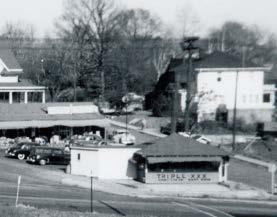



STORY AND PHOTOGRAPHY BY JENNIFER L. RUBENSTEIN


If you haven’t caught up with the new chef at The Garden Table, you should. Chef Matt Ward Myers has an open buying policy for his menu with local farmers: If you grow it, he’ll buy it. He then makes it his mission to show his customers how good this food can taste.

His menu is, in his own word, like a “chameleon,” and the patrons determine which of the day’s selections—jotted artfully on a chalkboard—survive and which ones don’t. His background is impressive, he is a bit of a bad boy and he cooks up one helluva meal.

Here are 20 things you might not know about Chef Matt Ward Myers, from the chef himself:

• I am obsessed to a nerd level about edible mushrooms. I grow them on coffee grounds, troll about them on the Internet, hunt them and cook them.
• I love cooks. When you become one you learn who you really are. Real pro cooks are the best people I’ve met.
• I love gardeners. When you don’t say “farm” it means something more intimate.

• I wish all of our jobs could be hobbies and our hobbies our jobs. Then again, I guess some people do get paid to drink beer and watch football.
• fall-back career.
• Indiana is well known in Sweden for inventing red-eye gravy. If you’ve never had it, or scrapple, let me know.
• I once cooked for the rapper Too Short, and Steve Perry from Journey, at the same time.

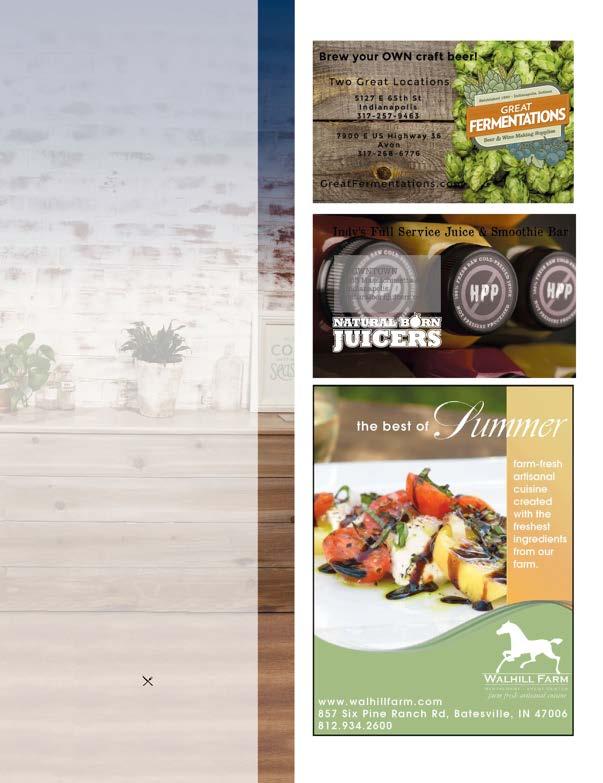
•
• My favorite meal growing up was cornmeal-fried morels with butter on white bread. It still might be.
• I am working on a breakfast cereal named Shenanigrams.
• I like beer. Look for events with us cooking from within the brew tanks of local brewers.
• If you go to New York City eat at Roberta’s because that’s it. Also M. Wells. In San Francisco, go to Lazy Bear, Coi and Grand Lake Kitchen in Oakland (California).
• If you spray dandelions with vinegar and bacon fat instead of Roundup they taste better.
• I use kimchi and Colby cheese to make a thing I call “kimcheetos.”
• I was the only American in my culinary school, and no one had ever tried ranch
• I grew up in Crawfordsville on my family farm. It is 100 years old and has one of the most amazing round Amish barns left in Indiana.
• I moved from Indiana to Vancouver, British Columbia. The police there do DUI checkpoints on foot. You can just keep driving. Or at least I did.
• They are like pets.
• New Yorkers never know where Indiana is. It’s fun to tell them it’s in different places.
• After all this time in cities where no one says hi to each other, the genuine smile and handshake of Hoosiers is a great feeling. Thanks for having me back. Now let me cook for you.
Catch Matt daily at The Garden Table, 908 E.
Two Great Locations
5127 E 65th St Ind ianapolis 317-257-9463
7900 E US Highway 36 Avon 317-268-6776
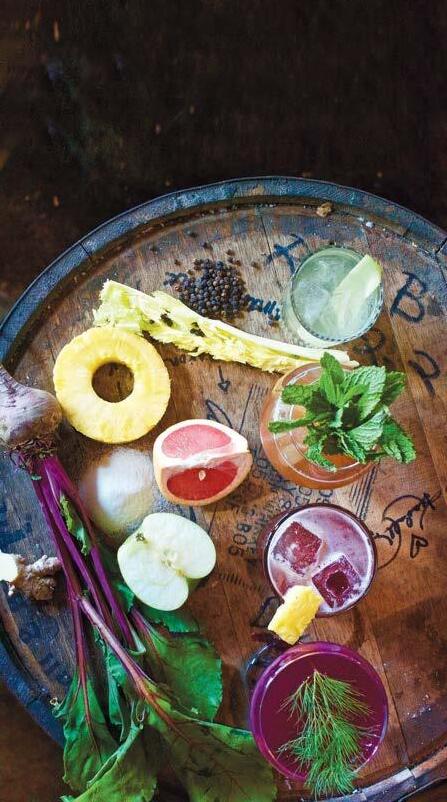
No, no, no, not the bush, silly. In the kitchen or bar a shrub is a zestful vinegar-based syrup that can be used to inspire your beverages and dressings to a new level. Shrubs date back to the 15th century as medicinal cordials, but became popular during the American colonial era when they were used in both cocktails and soft drinks.
The shrub we are speaking of is a acidulated liquid concocted of fruit and/or vegetable juice, sugar, vinegar and other herbaceous ingredients. Basic shrubs can be made with any flavor of vinegar, a sugar and fruits and/or vegetables, and our featured recipes include other ingredients such as ginger, basil and black pepper.
Try your hand at making these recipes and then venture out on your own and make your own creative shrub. Be sure to share those with Edible Indy on Instagram or Twitter by tagging them with #edibleindyshrubs—we may showcase them!
Combine ingredients in airtight jar. Refrigerate for 3 days, then remove fruit and strain. Serve. These will keep for up to 6 months in the refrigerator.
Tiki Time Out
1½ ounces Plantation 5-year rum
½ ounce Smith & Cross rum
½ ounce Grapefruit Basil Shrub
½ ounce orgeat
½ ounce pomegranate grenadine
¾ ounce lime juice
2 dashes Bittercube Jamaican #2 bitters
Shake and strain over ice. Garnish with mint.
Cognac the Barbarian
1½ ounces Pierre Ferrand 1840 cognac
1½ ounces Pineapple Ginger Shrub
¾ ounce Lustau Solera Sherry
½ ounce lemon juice
½ ounces Tempus Fugit Kina L’Aéro d’Or
½ ounce brown sugar maple simple syrup*
Shake and strain over ice. Top with a red
*Heat equal parts of brown sugar, maple syrup and water until dissolved. Cool. Store in refrigerator.

Grapefruit Basil Shrub
1 cup champagne vinegar
1 cup brown sugar
½ cup Ruby Red grapefruit slices
22 basil leaves
Black Pepper Beet Shrub
½ cup apple cider vinegar
½ cup white wine vinegar
1 cup white sugar
1 cup peeled and boiled beets
2 tablespoons whole black pepper
Celery, Spice & Everything Nice
1½ ounces Opihr Oriental Spiced Gin
¾ ounce Celery Apple Shrub
¾ ounce Carlo Alberto Bianco vermouth
¼ ounce honey water*
1 dash Bar Keep Fennel Bitters
Stir over ice. Strain over 2 ice cubes. Garnish with celery stick.
*Heat equal parts of honey and water until dissolved. Cool. Store in refrigerator.
Beet-Dilled
Recipe by Bridget Davis
1½ ounces Cabrito Reposado tequila
½ ounces Savory & James Amontillado sherry
¾ ounces lemon juice
½ ounce simple syrup
½ ounce Black Pepper Beet Shrub
Shake and double strain into a mescal rinsed coupe glass. Garnish with fresh dill.
Orchards, Farms & Markets
Greystone Family Farm
Lawrenceburg, Indiana
Beiersdorfer Orchard
Guilford, Indiana
Phillips Berry Patch
New Alsace, Indiana
Salatin’s Farm
Moores Hill, Indiana
Specialty Spirits
Great Crescent Brewery Aurora, Indiana
At the Barn Winery Logan, Indiana
Rowland Winery
Dillsboro, Indiana
Holtkamp Winery New Alsace, Indiana
Celery Apple Shrub
1¼ cup white wine vinegar
1¼ cup white sugar
¾ of a green apple, cored and sliced
2½ celery stalks
Pineapple Ginger Shrub
1 cup apple cider vinegar
1 cup turbinado sugar
½ of a full fresh pineapple, sliced
1 small ginger root, peeled and sliced
Content and Knife provided by Ash Blæds, Graphics by Caryn Scheving

Handle /’handl/
Comprised of the tang of the knife, which can be full or hidden. The handle material is affixed with slow cure epoxy and typically pins. Handle material can be made of wood or manmade laminates, but should always be smooth to the touch with no sharp edges that would create hot spots during prolonged use.
Pins can be made of multiple types of metals like stainless steel, copper or brass, or even multiples mixed into a mosaic pin configuration.
Blade /blād/
Straight high carbon steel strikes a good balance of hardness, edge holding and toughness. Hand sharpened to a mirrored, razor edge, this steel takes an incredibly sharp edge.
Spine /spīn/
Finger Guard /’fiNGgər gärd/
In a pinch grip, the middle finger rests against this part for comfort.
Heel /hēl/
Chopping tougher produce, some mincing tasks, but also is the start of long, mono-directional slicing motions.
Cutting Edge /’kədiNG ej/ Slicing and chopping .
The most controlled grip involves placing thumb and forefinger in a pinch grip on either side of the spine. The palm can be placed on the spine for some herb mincing, it is rounded for comfort.
Tip /tip/
Precision work like piercing and making small incisions.
Ash Blæds is comprised of Aric and Eric. They are Hoosiers who design and build beautiful custom knives for the kitchen and for the field. They focus on the community and sustainability. To learn more about their custom knives visit them at AshBlaeds.com


BY CHRIS WEBER | PHOTOGRAPHY COURTESY OF VIGO COUNTY HISTORICAL SOCIETY




“On the Banks of the Wabash, Far Away,” Indiana’s state song, written by Terre Haute native Paul Dresser, is but one of the many things Terre Haute has contributed to our state history. As Indiana celebrates its bicentennial, so does Terre Haute—possibly one of the most interesting, yet overlooked, cities in the state.
Terre Haute has a rich history that many know: from Hulman & Company, the industrialists that created Clabber Girl Baking Powder and saviors of the Indianapolis Motor Speedway, to the internationally relevant Sheldon Swope Art Museum, with an amazing collection of American art. Much of the city’s history, however, remains memories from the past; few know that the seventh largest brewery in the United States, Terre Haute Brewing Company, was once located here, or that the banks of the Wabash were once lined with distilleries, including the world’s largest at one time.
Terre Haute has a long association with many types of food and beverage production. A few examples were Anne Page products, made by the Quaker Maid Company and distributed by the A&P Co., which were available nationwide, and the Miller-Parrott Baking Co., which was known for crackers. However, there was also a strong community of growers in and around the city. To me, the most interesting of these was the J.W. Davis Company.
Locally known as Davis Gardens, the operation was located on US 41 roughly three miles south of the intersection with US 40, commonly referred to as the Crossroads of America. These two arteries were important to Terre Haute in general, and Davis Gardens in particular, in that they were the two longest federal highways before the interstate system was adopted. In addition, US 40 was originally the National Road, the first federal highway and conduit for much of our early westward expansion. Being situated at the convergence of the two main arteries for road transport gave the company a huge advantage. They could move products from Terre Haute to not only other cities, but also to ports for international sale. The company also sent produce by rail, and Terre Haute was once a robust rail hub. In addition, with the opening of Hulman Field (later Terre Haute International Airport), the J.W. Davis Company started to utilize airfreight. At one time, Davis Gardens produce was available on luxury ocean liners, at the tables of restaurants around the globe and even in the White House.
Started in 1914, the J.W. Davis Company was unique in that it was an indoor production facility. Originally, there were two or three greenhouses and the focus was on flowers; however, they would grow into a facility that had at least 39 greenhouses covering over 35 acres and growing primarily vegetables. By 1974, when they ceased operations, Davis Gardens was the largest indoor food production facility in the world. The facility was so large that, until recently, the outline of the greenhouses was still visible on satellite maps of Terre Haute. The facility even had its own coal-fired power plant. In addition to other uses, the plant produced steam that heated the greenhouses when needed. The temperature, moisture and soil pH were completely controlled to provide a consistent growing environment.
The gardens had their own beehives housed inside 10 of the greenhouses in order to pollinate the plants year round. And the operation was certainly year round; with the exception of August and September, when the soils were prepped and competition from other producers was high, the greenhouses were always producing flowers or vegetables. Even in the down months, the company was busy preparing for their busy winter season.
Although originally focusing on flowers, the J.W. Davis Company is mostly remembered as a producer of vegetables. In an era where
the seasonality of produce limited the availability of vegetables in the winter months, Davis Gardens could offer fresh produce year round. While they produced a number of varied vegetables, they were particularly known for a few specific crops. It is commonly reported that the J.W. Davis Company was the largest tomato farm in the nation at one time, and definitely supplied hothouse tomatoes to Chicago in the winter months. There are reports from the 1960s that over two million pounds of tomatoes were cultivated annually. Cucumbers were another of their staples; many of the historical photos available show cucumbers growing in the greenhouses. Supposedly the cucumbers were good for salads, and both the tomatoes and cucumbers are seen advertised as “salad” varieties.
Salad was an important aspect of the Davis Gardens operations. In addition to the Terre Haute facility, the J.W. Davis Company had smaller greenhouses in Davenport, Iowa, and Aurora, Illinois. These were supposedly used for growing even more of the real innovation of the company: Bibb lettuce. While not created by the J.W. Davis Company (the hybrid is attributed to a veteran of the War of 1812, Lt. John Bibb), nor initially brought to the commercial market by them, Davis Gardens was the first company to produce this lettuce on a truly massive scale.
They solved the problem of how to grow the lettuce for much of the year, reportedly planting the first crops in September and growing continuously through May of the next year. An article from the Saturday, August 5, 1962, edition of the Indianapolis Star reported that “Beginning next month [September], the Davis company workers will sow 80,000 to 250,000 Bibb lettuce seedlings weekly. Then from October through May about 3,500 fivepound baskets of Bibb will be harvested weekly.”
This was supposedly only at the Terre Haute facility; the other two locations would have added even more capacity. The company had a system by which up to 10,000 seeds could be planted per hour. This was their real innovation: year-round lettuce at a time when lettuce had previously only been available as essentially a spring and fall crop. With the hothouse tomatoes, salad cucumbers and Bibb lettuce, one could make a salad in any season.
So why did such a large company, with international sales and a huge facility, fail to survive into the current era? There are a few reasons. The first is in how they powered their facilities. By 1974, new regulations were starting to change the landscape of the United States. The Environmental Protection Agency had been established and the Clean Air Act passed, which made it more difficult to operate older power plants like that utilized by Davis Gardens. By 1979, even the smokestacks for the power plant had been demolished.

Bibb Lettuce being picked and grown in 1939 when Davis first started to work with it.
Cucumbers, fresh planted in one of the greenhouses.

“A

Another factor was related to the J.W Davis Company’s early success. By 1967 Interstate 70 had reached Terre Haute, crossing over US 41 just north of Davis Gardens. While the interstate system was valuable to companies like Davis Gardens, it also made it easier for similar companies to move produce. Specifically, companies in California and Florida were now able to grow produce year round because of the favorable climate in those states without the need for expensive greenhouse operations. After the 1970s, as fuel prices lowered and trade restrictions changed, vegetable production also moved into a global market. Few companies like the J.W. Davis Company could compete in the changing landscape of the produce market.
As a local hobby grower and passionate advocate for local food, I find it heartening that there is a resurgence of similar truck-farmstyle food production. There are urban farms and small-scale producers relearning how to provide food on a local level. While places like Davis Gardens might not be currently feasible, there is hope that such operations can blossom with a new focus on fresh and local foods. In some ways, Terre Haute is lagging behind that movement; however, the defining model for how it can work is still part of our local community and maybe a similar operation can be one of the ways that Terre Haute leads the state into the next 200 years.
A Terre Haute transplant, Chris Weber came to Indiana to run the local coffee company, Rex Roasting Co., for Clabber Girl Corporation. Soon after relocating, the history and unique character of his adopted city became apparent. Chris has written articles and volunteered for multiple organizations in his area. He is particularly interested in the intersection of architecture, transportation and food that make up Terre Haute’s 200-year contribution to local and national history.



STORY BY KAREN KENNEDY | PHOTOGRAPHY BY STACY NEWGENT | GRAPHICS BY CARYN SCHEVING
Locally sourced ingredients whenever possible


These phrases appear regularly on restaurant menus, websites and marketing materials. They’ve become de rigueur when describing any new concept, and the use of these terms is rarely questioned.
Theoretically, every restaurant is “farm to table,” as the vegetables they use were most definitely grown on a farm somewhere and they eventually land on the table—but how many stops did those vegetables make along the way, and where was the farm that grew them? And what, exactly, does “whenever possible” mean? Five pounds of lettuce mix in July from a farm down the road? A bushel of peaches from the one time it was “possible” to get to a farmers’ market?




The fact is, many restaurants are talking the talk when it comes to “local” but not all of them are walking the walk. Granted, it’s not easy. Small local farmers are at the mercy of weather, transportation, yield and time, which can complicate the lives and schedules of chefs, who need to know what’s coming in and when as they’re planning their menus and juggling their inventories.
“You ordered 10 pounds of cucumbers, but the beetles got half of them. What do you want instead?”
“Not gonna have the radishes. Top of the roots got frozen.”
“The deer ate the lettuce.”
These are samples of the text messages that fly between Patachou’s Executive Chef Tyler Herald and local farmers on a regular basis, 24 hours a day, seven days a week, and he rolls with all of it.
Tyler Herald is walking the walk.
With the walk-ins of 10 busy restaurants to stock, it would be easy to decide that dealing with more than 20 different small purveyors is too complicated, when he could just pick up the phone and get everything he needs from one source. But Herald has a commitment to all things local that runs deep.







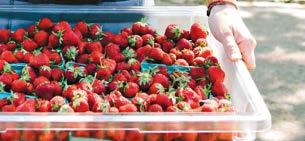



800 Pounds THE AMOUNT OF CHICKEN PATACHOU BUYS PER WEEK FROM MILLER AMISH COUNTRY POULTRY IN GOSHEN.
800 Pounds 400 Heads 75 Pounds
RESPECTIVELY, THE AMOUNT OF TOMATOES, RED LEAF LETTUCE AND BASIL PATACHOU BUYS PER WEEK FROM SILVERTHORN FARM IN ROSSVILLE.

$140,000 T HE ANNUAL AMOUNT P ATACHOU WILL SPEND ON PRODUCE FROM S ILVERTHORN F ARM
$85,000 THE ANNUAL AMOUNT PATACHOU WILL SPEND ON BEEF FROM FISCHER FARMS IN JASPER.

$39,000 T HE ANNUAL AMOUNT P ATACHOU WILL SPEND ON PRODUCE FROM F ULL H AND F ARM IN N OBLESVILLE


designed by Caryn Scheving
“For me, it started when I was kid, hanging out in my mom’s restaurant,” said Herald. “We would pick up some tomatoes from a roadside market, or a customer would bring in a bag of cucumbers from the surplus of their garden, and I remember thinking, ‘Wow, this tastes so much better than the other stuff.”
As his travels took him to Wisconsin and Oregon in the late ’90s and in early 2000, he noticed the trend of restaurants putting the names of the local farms they bought from right on the menus. And when he finally landed at Café Patachou in 2008, he found a kindred spirit in his commitment to local in owner Martha Hoover.
For Herald, “local” is defined as anything from the state of Indiana, from as far away as 130 miles and as close as the garden just outside the front door of Public Greens (one of the many restaurants that are part of the Patachou family). He takes enormous pride in the fact that in the summer months, the menus at Napolese (also a Patachou cousin) and Public Greens are nearly 100% local, with the exception of Parmesan cheese, which no one in Indiana produces.
This commitment is the reason you might find Great Lakes trout on a menu, but never shrimp. And why you’ll never be able to get a Caprese salad in February.
“When we opened Napolese, our customers learned quickly that it wasn’t going to do them any good to complain about their favorite salad going off the menu. They realized that it would return the next year. And in the winter months, they grew to embrace Brussels sprouts,” he said with an impish grin.
As we chat on a rainy and chilly March morning, he gets a faraway look in his eyes as he dreams about the summer bounty that’s just around the corner.
“There is a night-and-day difference between local arugula, spinach and tomatoes” and their counterparts trucked in from across the country or beyond, said Herald. “Literally, night and day. And the strawberries… oh, the strawberries... I remember a few years ago I tasted a strawberry from Wild’s Apple Farm in Zionsville, and I ran to the other cook in the kitchen and I was like, ‘Taste this, man! This, this is what a strawberry is supposed to taste like!’ They shouldn’t even be allowed to call those other things strawberries. It’s a completely different fruit.”
For Herald, the relationships he develops with the local farmers are just as important as the quality of the food they provide. Some of these farmers have adapted their business models to grow exclusively, or nearly exclusively, for Patachou.
“I’ve known some of these farmers for years,” he said. “I know their families. I’ve watched their children grow up. These folks don’t do it to get rich. They don’t do it to buy fancy cars. They do it out of love and passion and I believe we have an obligation to support that.”
Another source for local produce is Butler University’s Center for Urban Education (CUE). “The students actually approached me,” said Herald. “And of course I said yes.” In the summer months, the student growers bring a bounty of tomatoes, peppers, green beans, kale, arugula, snap peas, squash and asparagus.
For the most local of the local growers, transportation is no problem. But for some that travel from the farther corners of Indiana, logistics can be tricky.
“With Gunthorp, it’s one guy, one truck,” said Herald. “Greg [Gunthorp] is just loading it all up once a week and driving it over here. If his truck breaks down, we’re all in trouble.”
Deliveries from so many different vendors makes for hectic kitchen back doors.
“There are people in and out of the delivery door all day long sometimes,” Herald said. “And growers that I haven’t even ordered from will stop by and ask if I’m interested in what they have left over from a farmers’ market. Or maybe they had a bumper crop of something. I always take it off their hands if I can.”
Opposite: Full Hand Farm contributes arugula, head lettuce, heirloom tomatoes, radishes, leeks, rainbow carrots, beets, kale, chard and more for Napolese and Petite Chou. As for Public Greens; “Public Greens is a full representation of everything we grow; if we grow it, Tyler wants it at PG.”


Herald does concede the price he’s willing to pay for locally produced ingredients might be more than some smaller restaurants can get past. After all, he’s got the buying power of 10 restaurants behind him, and an owner who firmly believes quality trumps price every time. But no matter how much the principle of economies of scale applies, each plate that leaves the kitchen has to make money or everyone involved is out of work. Yet tending to a food cost percentage can be especially tricky when a couple of weeks without rain can double the price of a particular ingredient. Herald has learned to work around this over the years by pricing on the average of ingredient costs.
Herald conceded that it takes “a ton” more effort to do what he’s doing with local farmers.
“But everything we do ties into the mission. Public Greens is all about feeding the local community. How would it look if we were using food from out of the state or out of the country to do that?”
There was a time when Herald did all of the ordering for all of the restaurants himself, but he’s learned he has to delegate. But he is ever vigilant that all of the kitchen staff in all the restaurants shares his passion and his respect for the work of the farmers who grow for them.
“It takes a lot to make me mad,” he said. “But if I walk into a kitchen and someone has tossed something on top of a clamshell of

beautiful strawberries, I will go nuts on them. You know, you have to respect the circle of life. If you waste one clamshell of strawberries, you didn’t just waste the strawberries. You wasted all of the time, effort and love of the farmer who worked so hard to grow those strawberries. You’d better respect it. Cherish it.”
As Indianapolis diners hungrily gobble up every bite of “local” Herald and his culinary team can put on their plates, Hoover and Herald are eyeing broader plains. Communities such as Bloomington and Nashville may soon enjoy what Circle City residents have come to take for granted.
“We’re definitely talking about more restaurants in new cities,” said Herald. “And how exciting is that? A whole new ‘local’ to explore; a new ecosystem. Things grow there that don’t grow here. They call the Midwest ‘the Heartland’ for a reason. It would suck to live someplace like Texas, where the seasons don’t change. How boring would that be? Indiana has an amazing bounty to offer. There’s nowhere else I’d rather be cooking.”
Karen Kennedy, the Circle City’s “Maven of Merriment,” is an Indianapolis-based food writer with over 25 years’ experience in the hospitality industry in Indiana, Chicago and Vermont. She loves nothing more than a party, and is the owner of Small Potatoes, a catering and event planning company specializing in unique, creative, custom hors d’oeuvres receptions and small dinner parties.
Indy City Market
The Original Farmers’ Market is in its 19th season at the Indianapolis City Market and boasts more than 60 seasonal vendors selling fresh eggs, meats, cheeses, produce, honey, syrups, vegetable starts, flowers, baked goods and much more! May 4 is this season’s kickoff!
222 E. Market St.
Indianapolis May–Oct.
Wednesday 9:30am–1:30pm IndyCM.com Accepts: SNAP
Kokomo Downtown Farmers’ Market
The Kokomo Downtown Farmers’ Market is celebrating its 15th season of providing the best in locally grown, handpicked, homemade, farmfresh goodness to our community. Live music and kids’ activities weekly!
At the intersection of Mulberry & Washington Streets
June 8–Sept. 21
Wednesday 4–7pm
May 7–Oct. 8
Saturday 9am–1pm KokomoFarmersMarket.com Accepts: SNAP
Greenwood Farmers’ Market
Greenwood Farmers’ Market is celebrating its 26th season this year. With more than 45 seasonal vendors featuring Indiana produce, crafts and baked goods, honey, fresh eggs, plant starts and cut flowers. Also available are fresh lamb, beef, pork, chicken and much more!
United Methodist Church parking lot
525 N. Madison Ave.
Greenwood May–Oct.
Saturday 8am–noon
Brownsburg Farmers’ Market

Noblesville Main Street Farmers’ Market
4 — 7 pm THUR June 2 - Sept. 8
Town Hall Green
Readers of the Hendricks County Flyer voted the Brownsburg Farmers’ Market the “Best of Hendricks County” for the third consecutive year! The Town of Brownsburg and IU Health West Hospital partner to bring fresh produce, artisan baked goods and handcrafted items to local shoppers at the Brownsburg Farmers’ Market each summer on the Brownsburg Town Hall Green.
Brownsburg Town Hall Green
61 N. Green St.
Brownsburg
June 2–Sept. 8
Thursday 4–7pm Accepts: SNAP, Fresh Bucks, WIC
JCC Farmers’ Market
Shop for fresh local produce, baked goods and dairy products at the JCC’s year-round farmers market, Indy’s only regularly scheduled farmers’ market on Sundays.
6701 Hoover Rd.
Indianapolis
Sunday 10am–1:30pm
JCCIndy.org Accepts: SNAP
Join us for the oldest and largest farmers’ market in Hamilton County, with more than 80 vendors featuring local artisan products, produce and more! This is the last year the event will be located in the overflow lot of Riverview Health. Visit Facebook page or website for information on event days.
839 Conner St.
Noblesville
May 7–Oct. 15
Saturday 8am–noon
Accepts: SNAP, WIC

Saturdays 10am-2pm June 11-Oct 15

WSTORY AND PHOTOGRAPHY
BY JENNIFER L. RUBENSTEIN
andering up the coast of Maine from Portland to Camden is like stepping back in time. Small villages stand still from ages of the past— roadside organic stands, natural food stores on every corner, meat markets with only the freshest local meats and handwritten signs on the side of the road directing drive by traffic to pull in for $5.99 live lobsters. A locavore’s dream … and a daily reality for many Mainers.
When talking to the famed Chef Sam Talbot, of Bravo’s “Top Chef” and author of the Sweet Life and the upcoming book 100% Real, he explained this is simply a way of life for Mainers. Sam, a New Yorker, has opened the quaint farm-to-fork restaurant Pig + Poet in the historic Whitehall lodge in Camden. Sam is passionate about fresh ingredients, saying “Everything we use as ingredients are a skateboard ride away.” This is not easy in Maine, where over 90% of the land is covered in forest and 100% experience harsh winters. That forces people to hunker down, preserving food. Local, fresh food is a age-old survival mechanism, not a trendy urban hipster movement.

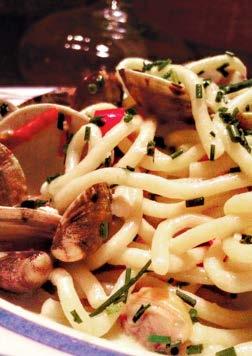
Chain restaurants are rare in the coastal cities of Maine, while mom-andpop restaurants, shacks and food trucks can be found in every little town, island village and city. This region, known as the Jewel Coast, has drawn some of the best freshly prepared food in the state and is home to a handful of James Beard Award winners and nominated chefs. Bobby Flay of the Food Network, and even “The Chew,” love this region. During our stay we visited several places that have been touched by the hands of the above famous foodies and we laid our heads where history, art and Maine life will impress you. It did us.
Chef Sam Talbot/Historic Whitehall
Camden
PigAndPoetMaine.com
This intimately farmer-chic restaurant, located in the beautifully historic Whitehall lodge, draws you in immediately from the decor to the smell of the sea. One of famed Chef Sam Talbot’s babies, this hits all of his sweet spots. His love of locally sourced and thoughtful food is showcased on his menu, which is seasonally designed. Chef Talbot is passionate about keeping the ingredients as real as possible. As we dined on lamb bacon la plancha, Chef Talbot casually strolled over to our table to sit and chat with us. Chef Talbot is known to wander from table to table, and is seen regularly making special dishes that may tease your senses. His favorite dish on the menu by far is the buttermilk fried chicken with duck fat roasted potatoes and kale chips. On that particular day, his staff enjoyed a dinner he had to bring out to us to try—fresh mussels with vegetable confit (fit for a king). Of course, we washed down that delicious dish with his favorite cocktail of raw cucumber juice, gin, agave and basil. Not only is this restaurant open for lunch and dinner, you stay at the lodge built around 1901, and the built-in breakfast is like nothing we have seen. It might make you need to wear yoga pants for the day.
Chef Melissa Kelly Rockland
PrimoRestaurant.com
Primo is not only an award-winning restaurant run by a two-time James Beard Award–winning Chef Melissa Kelly, it’s a 4.5-acre working farm. Chef Kelly creates brilliant cutting-edge fresh dishes that change daily with sometimes 80% of the food coming from her farm. The restaurant sits at the bottom of a hill; the hill above is her farm, filled with chemical-free rotating crops such as nettles, asparagus, roasting vegetables, and of course she has apple trees inside the areas where the pigs roam and the roosters crow. Her menu is impressively delicious. Cornmeal pancakes with braised lamb ropa veija are a staple starter, to fortify you while drooling over which Maine dishes to devour. From the panseared local scallops to the pork saltimbocca, you can get a small taste of the culture and roads Chef Kelly has traveled—and we must say, she has traveled well. She allowed us to indulge in her famous house-made cannoli stuffed with fresh ricotta and rolled in crushed pistachios and Amarena cherries … that dessert alone is a reason to make a reservation at Primo. Take a tour of the farm, grab some vino and make an evening of the ultimate cuisine.
Top: Chef Sam Talbot, Pig + Poet.
Left: Primo Restaurant freshly harvested mussels from steps away.
Chef Brian Hill
Rockport
ShepherdsPieRockport.com
Located on a breathtaking harbor, Rockport depicts what visitors come from afar to photograph. The harbor is full of lobster boats and sailboats, all glistening at sunset amid the rich colors of the season, the smell of salt and the tranquility of calm water. Shepherd’s Pie is the creation of Chef Brian Hill, a favorite of Bobby Flay and featured in an episode of his “Throwdown with Bobby Flay.” Shepherd’s Pie, named for the historic Shepherd Company building, does indeed serve shepherd’s pie, but they are known for their seasonal menu that gives a radical twist to coastal rustic dishes. Local roasted corn with bonito flakes gives the appearance of being alive, waving back and forth much like sea kelp in the ocean. The flakes add a dark, deep and salty flavor. Scallops braised to perfection over a bed of kelp, tarragon and crispy capers melt in your mouth, sending you into a blissful food coma. Also, don’t forget a butterflied grilled pork sausage over two crisp chickpea polenta cakes enhanced with a kalamata-tomato sauce. Seasonal pickles add a hint of a crunchy giardiniera-style relish, that’s crunchy, spicy and on the edge of insanity with the vinegar and pepper sauce. There is no wonder why this restaurant with no sign, hidden on a tiny harbor, was a nominee for James Beard’s Best New Restaurant.
Owls Head
In 2009, Food Network said this place had the best burger in Maine, and the 7 Napkin Burger didn’t disappoint. This massive half-pound burger layered with tomatoes, thinly sliced pickles, shredded lettuce, mayo, catsup, mustard and onions leaves your face drenched, your hands dripping and you will smell of those onions all day, but the result is worth it. This two-room general store, next to the Owls Head post office, has an outdoor restroom near the Owls Heads Lighthouse, where lobster boats will pull any foodie in who wants to eat where the locals go. While there, don’t miss out on one of the Maine Root natural sodas. We recommend the blueberry.
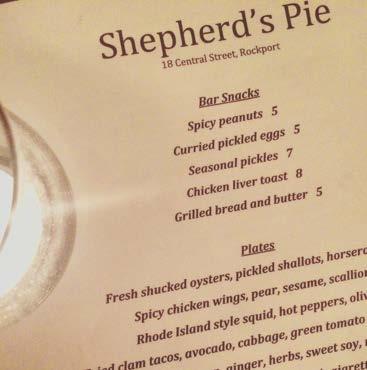
The famous Owls Head 7 Napkin Burger.
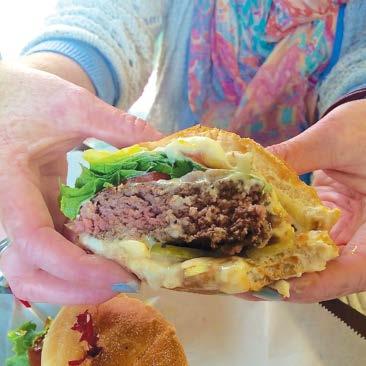

Above: The famous lobster roll from Red’s Eats in Wiscasset will leave you dripping with mayo and butter! Now that is finger lickin’ good!
Wiscasset
History has been made with these lobster rolls. You’ll wait in line and you must have cash. The price for a lobster roll is written on a posted piece of paper and changes daily. Thinly sliced white bread, toasted with butter and heaped with over a pound of lobster caught and cooked that day—our roll had four claws on it—is handed to you on their signature red plates in aluminum foil with a packaged wipe for good measure. This stand is so popular you can find copies of their book, Red’s Eats: World’s Best Lobster Shack, throughout Maine, and you will find people who have been coming weekly for as long as the stand has been on the corner of this quintessential Maine harbor town.
Right: Signs for live lobsters are found on random coastal roads up and down the coast of Maine.

The only way to stay in Maine for the full experience is to stay in one of their famous bed and breakfast inns. Many are historic and all of them are topnotch not only with their rooms and fun-loving innkeepers, who will keep you on your toes with laughter and enjoyment, but the food … oh, the food.
LimeRockInn.com
This inn was voted for having the Best Wrap Around Porch by Yankee magazine’s Best of New England, Down East magazine’s Readers Choice, Hall of Fame for multiple years by Trip Advisor, and we know why. This beautiful Victorian mansion, located in the Historic District, is beautifully landscaped and full of luxury and comfort. Innkeepers Frank Isganitis and PJ Walter, like many Maine foodies, believe in simple, fresh and good food that creates a culinary experience. Warm breads and pastries greet you, along with the aroma of fresh coffee from local Rock City Roasters. House-made waffles, gourmet eggs, French toast and the special breakfast item of the day beg you to come back for more the next morning. This is truly a home away from home with friends you have never met.
BerryManorInn.com
The Pie Moms—heard of them? They have been featured on “The Chew,” “Throwdown with Bobby Flay,” the Travel Channel and more. Pies are what this Inn is known for—always available warmed or not, à la mode or not, in your room or not—but pies are not the only attraction. Berry Manor has been named more than once as a top B&B in the United States, and this stately home of one of Rockland’s most prominent merchants is luxurious, relaxing, elegant and more. Although the husband-and-wife team, Cheryl Michaelsen and Mike LaPosta, offer up humor at breakfast with a rather large collection of toy hamsters and wacky hats, they aren’t joking about the culinary treats they provide at breakfast, and of course, their mom’s pie recipes.
OldGraniteInn.com
This inn across from the harbor began as a Federal Colonial residence built of gray granite, hence the name. The quaintness of the inn fills you with nostalgia, a feeling of being in a family home. At the same time the walls and tables are filled with unique works of art that will catch your eye with every turn. This 1840 house has all the modern conveniences with rooms with simple, yet contemporary, furniture and feel. Husband-and-wife innkeepers Joan and Edwin Hantz are creative thinkers and doers who put those talents
The Lime Rock Inn (top) delights you with their morning wake up call for breakfast. The Berry Manor Inn (middle) has freshly made pies and ice cream 24/7 to fill your tummy and make you happy. The Granite Inn (bottom) sits across from the coast with a spectacular view inside and outside of the inn. (Photographs courtesy of the inns.)





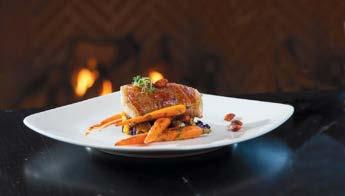
to work in the gardens and famous breakfast for which the inn in known. Edwin wakes up early every morning to grind fresh coffee and fill the air with the smell of his freshly baked scones. His creative cooking extends to seafood and vegetable juices and the gourmet crêpes drenched with real Maine maple syrup and blueberries. You will be on sensory overload with the scrumptious foodie and art experience the Hantz family will provide.
Cape Elizabeth InnByTheSea.com
As the closest airport isn’t so close to the Jewel Coast, flying in and out of Portland may be the best option, with an unmistakably beautiful drive up to the coast. If you do fly in or out, or decide to stay in Portland for any time, a breathtaking place to close your eyes is the Inn by the Sea. This award-winning eco-luxury hotel gives guests a panoramic view of the ocean that will fill anyone with relaxation. The rooms are opulent, yet earthy. This beautiful inn is not only an environmental leader—being the first in Maine to bear solar panels and use biofuel— but they also collaborate with the Maine Department of Conservation to restore the endangered New England Cottontail bunnies at Crescent Beach State Park. The inn has developed an onsite program for planting indigenous plants to create a safe habitat and food for these bunnies. In addition, the inn has an onsite gardener responsible for planting edible landscape around the grounds such as artichokes, cabbage, kale, edible flowers and other items, which can be used as fresh ingredients at Sea Glass, the onsite restaurant. Chef Steve Sicinski infuses his menu with seasonality and nutritional balance. Using local produce and lobster is nothing new for Sicinski. He shares with other Maine chefs a passion to incorporate under-appreciated seafood onto the menu. His menus feature underutilized seafood such as dogfish, whiting and monkfish, in efforts to help restore the abundance of over-caught fish off the coast and introduce his guests to new flavors. The inn is pet friendly, Cottontail friendly, eco-friendly, but most of all it is good-for-you friendly. A getaway that will take your breath away and leave you filled with an experience of a lifetime.
At top: a perfect Maine view of the Rockport Harbor. Middle: The 1902 Rockland Harbor Breakwater Light sits at the south end of a 4,300 foot breakwater. Bottom: One of the many delicious sea-to-table dishes from Chef Steve Sicinski, Sea Glass at the Inn by the Sea.
Serves 4
12oz spaghetti
8oz Saint Adrian Meats & Sausage lamb bacon, chopped into ½” dice 4 cloves garlic, minced
2-3 large fresh eggs (3 if you like it a bit more ‘saucy’)
½ cup freshly grated Parmesan cheese, plus more for serving at the table ½ tsp freshly ground pepper
Do not prepare any of the other ingredients ahead of time. Heat from the just-cooked bacon and pasta help to ‘cook’ the raw egg sauce.
In a non-stick skillet over low to medium heat, fry bacon until it is just beginning to get crispy and fat is rendered. While bacon is cooking, cook spaghetti.Turn off heat

and add garlic, stirring well to mix with bacon.
In a large bowl (enough to hold the pasta), beat eggs well and add pepper. Whisk 1/4 cup of the cheese into the beaten eggs and mix well,adding remainder of the cheese. When spaghetti is done, reserve 1/2 cup of pasta water, immediately drain and add the hot spaghetti directly to the egg mixture. Toss spaghetti until all strands are well-coated. The hot spaghetti cooks the raw egg sauce. If sauce seems too thick or ‘dry’, add reserved pasta water a few tablespoons at a time until desired consistency. Add lamb bacon with garlic, including as much of the rendered fat as preferred. Toss well. Allow to sit for a few minutes to thicken. Serve with extra grated cheese.
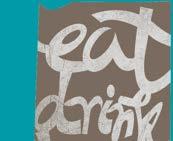


The Garden Table is a local eatery and fresh juicery in the heart of the Broad Ripple Village. We serve seasonally influenced and locally sourced food and cold pressed juice. We believe in simple dishes, made from natural ingredients, grown and harvested by local farmers. Downtown location opening soon. 317.413.3778. TheGardenTable.com
908 E. Westfield Blvd., Indianapolis, Tu–Sa 8am–3pm, Su 9am–3pm.
Looking for a great burger and beer? Look no further than Punch Burger. Our award winning burgers are made from local grass-fed beef provided by Fischer Farms in Jasper, Indiana. Our beers crafted are from local breweries such as Sun King, Quaff On, Scarlet Lane and more. Need a suggestion? Make sure to order up our famous Burnt Cheese burger and a side of sweet potato tots . You won’t be sorry! PunchBurger.com



Downtown: 137 E. Ohio St., Indianapolis, 317.426.5280. Su–Th 11am–9pm, F–Sa 11am–10pm 12525 Old Meridian Ste. 100, Carmel: 317.564.0637. Su–W 11am–9pm, F–Sa 11am–10pm
Getting Hoosier-grown goodness on your plate doesn’t have to involve hours in the kitchen. These fine establishments proudly serve up the freshest locally sourced cuisine.
The farm-to-table movement begins with Central Indiana farms and dedicated producers who care about bringing only the best to market, which is a very good thing for locally owned restaurants that search out the best dairy, meat, produce and beverages for their patrons.
Farm-to-table is gaining momentum not only with bornand-bred Hoosiers, but the many visitors to Central Indiana. Edible Indy connects growers, producers and food artisans with their community.
Here is a select list of some of those chefs and owners who take great pride in celebrating Hoosier-grown goodness.
*This is a paid advertisement.


St. Elmo gives a big thank you to our local partners! As a locally owned business for over 110 years we take great pride in our local business relationships. Cheers to independent businesses! 317.635.0636, StElmos.com
127 S. Illinois St., Indianapolis, M–F 4–11pm, Sa 3–11pm, Su 4–10pm

Milktooth is a neighborhood brunch destination, serving up Indy’s first Mod Bar coffee program along with upscale breakfast and lunch. Focusing on seasonal, local ingredients— everything is made in house. 317.986.5131, MilktoothIndy.com 534 Virginia Ave., Indianapolis, W–M 7am–3pm
A Mass Avenue staple offering non-hpp raw juices and smoothies in a hip and trendy walk-in location. All juices are cold-pressed, old school centrifuge, and freshly juiced on site and their cleanses programs are available year around. 317.797.4254, NaturalBornJuicers.com
865 Massachusetts Ave., Indianapolis. M–F 7am–7pm, Sa 9am–7pm, Su 10am–6pm


We’re proud to keep it local at Harry & Izzy’s! Three restaurants sourcing locally from 10 regional farms, four breweries and seven locally owned purveyors or producers leads to one great meal. All open M–Th 11am–11pm, F–Sa 11am–midnight, Su noon–9pm. HarryAndIzzys.com
Downtown: 153 S. Illinois St., Indianapolis, 317.635.9594 Northside: 4050 E. 82nd St., Indianapolis, 317.915.8045
Airport: 7800 Col. Weir Cook Memorial Dr., Indianapolis, 317.241.0533

Oakley’s Bistro, a neighborhood American Bistro focuses on rotating seasonal menus encompassing the Midwest rustic appeal with local sustainable ingredients making every meal a special occasion. Owner and operator, Chef Steven Oakley is a James Beard Nominee with Bon Appétit recognizing the bistro as “one of the hottest restaurants coast to coast”. Join Chef Oakley at this Northside Indianapolis staple for lunch or dinner, whatever the occasion, the experience will be divine. 317.824.1231, OakleysBistro.com
1464 W. 86th St., Indianapolis. Lunch: T–Sa 11am–1:30pm, Dinner: T–Th 5–9:30pm, F–Sa 5–10pm










Hotel Tango, the first small batch distillery in Indiana and is also the first service disabled, combat veteran owned distillery in the country. Using only high-quality, local ingredients allows us to stand out. We invite you to come in and taste what our Hoosier heads, hands, and hearts have made, sit by the fire, or belly up at the bar. Drink local, buy local. 317.653.1806, HotelTangoWhiskey.com
702 Virginia Ave., Indianapolis. M–F 2–10pm, Sa–Su noon–10pm


Founded in 2005, Chef JJ’s is a unique, personal and hands-on culinary experience with a focus on the Big Green Egg®, corporate team building, private events and grilling classes. Chef JJ’s provides clients with the most innovative culinary experience in Indianapolis. Our multi-course meals are prepared and served backyard or family style. We offer distinctive private dining opportunities for your event with personal attention to detail. Call us to set up your event today. 317.602.3828, ChefJJs.com
Downtown: 42 W. South St., Indianapolis 1040 Broad Ripple Ave., Indianapolis, M–F 11am–6pm, Sa 10am–5pm.
Cardinal Spirits is a craft distillery and cocktail bar just off the B-Line in Bloomington. We combine ageold distilling techniques with modern technology, and specialize in creating memorable experiences. CardinalSpirits.com
922 S. Morton St., Bloomington, M–Th 4–10pm, F–Su 12pm–12am, 812.202.6789









From a store full of fresh, seasonal foods and a team of Chefs and Culinary Experts comes a celebration of food called table by Market District — a restaurant that brings passion for food right to your plate. Open daily for lunch & dinner, as well as brunch every Sunday. 317.689.6330, MarketDistrict.com/Table
11505 N. Illinois St., Carmel. Su–Th 11am– 9pm, F–Sa 11am–10pm

Dine at a true farmstead restaurant, located inside a beautiful historic barn on an organic dairy farm. Food grown and raised on-site takes center place on organic menus shaped by seasonal rhythms. Open for Lunch, Dinner, and Sunday Brunch. 317.733.1700, TraderspointCreamery.com

9101 Moore Rd., Zionsville. Lunch: M–Sat 11am–2:30pm; Dinner: Tu–Th, Su 5–9pm, F–Sa 5–9:30pm; Sunday Brunch: 9:30am–2:30pm

Upland offers a brewpub, beer bar, tap house and tasting room, all serving up Indiana’s finest craft brews,gourmet burgers to beet and pesto pizza. The Carmel Tap House and the Brew
Pub have full service lunch and dinner menus.
For a full listing of locations visit UplandBeer.com
Bloomington BrewPub: 350 W. 11th St., Bloomington, M–Th 11am–12am, F–Sa 11am–1am, Su 12pm— 12am, 812.336.2337
Carmel Tap House: 820 E. 116th St., Carmel, M–Th 11am–12am, F–Sa 11am–1am, Su 12pm–12am, 317.564.3400
Local Roots, California Wines (and vibes)! If you love tasting great Napa Valley wine in a fun, eclectic, groovy atmosphere, then Peace Water Winery is your place!

Best yet, 50% of our profits are donated to charities. So come in for a tasting, buy a glass, take home a bottle or join our wine club and learn how “One Bottle Does a World of Good!”. 317.810.1330, PeaceWaterWinery.com
37 W. Main St., Carmel, T–Th 2–9pm, F–Sa noon–10pm, Su noon–5pm



By Jennifer L. Rubenstein, Design & Photography by Caryn Scheving
Indiana blueberry season is July – September.
According to the Blueberry Council, 38 states grow blueberries, however 10 states, including Indiana, make up 98% of commercial production.
Americans consume over 700 million pounds of blueberries each year.

The 50th Annual Marshall County Blueberry Festival takes place each year in Plymouth during Labor Day weekend. It’s a weekend of entertainment, arts and crafts, a parade, the blueberry stomp race, an autoshow, fireworks and of course eating anything and everything blueberry! To learn more about the festival visit BlueberryFestival.org



Indiana’s high bush blueberries – sweet, sour, big and small – thrive in the Northwest Indiana countryside due to the enriched soil. There blueberry lovers will find over 600 acres of family-owned blueberry farms. Weekend drives make u-pick the perfect afternoon activity. And if you’re not the picking kind, you can buy them hand-picked by the pound at most blueberry farms.

Here are our top picks for afternoon drives full of healthy & delicious family fun!
Hours are seasonal. Check the website for opening dates!
Blueberries of Indiana
2388 W. 1000 N., LaPorte W—M 8am—6pm BlueberriesOfIndiana.com
Holy cow! They have been selling fresh blueberries since 1948. They know how to pick ‘em.
Bonnell’s Blueberry Patch
3655 S. 750 W., North Judson M—Su 7am—6pm BonnellsBlueberries.com
Freezing blueberries for year round goodness
1.Pick your berries.

2. Do NOT wash your berries as this makes the skins tough when you freeze them.
3. Spread them out in a single layer on a cookie sheet and freeze.
4. Remove from freezer and place blueberries in a plastic sandwich bag or airtight container.
5. Place in freezer. Keep for up to six months.



Good to know: It’s a family affair! You will find a group of ornery sisters picking blueberries, telling jokes and making everyone laugh. It’s like you walked into an episode of the Golden Girls with Betty White!

Evers’ Blueberry Farm
13340 N. 700 W., DeMotte M—Sa 7am—5pm EversBlueberries.com
History note: The farm started in 1935 as the Evers’ grain farm and in 1947 blueberries were planted and the rest they say is history...
Johnson’s Farm Produce
8960 E. Ridge Rd., Hobart M – Sa 8am—6pm, Su 9am—4pm JohnsonsFarmProduce.com
Don’t miss: July 16 & 17, Blueberry Madness. Fresh blueberry shortcake, donuts, pie eating contests, blueberry sundaes and fun for the whole family!


Catch the vibe, taste the flavor in Lafayette–West Lafayette!
Visit the downtown area to savor a variety of cuisines at delectable, locally owned restaurants, many of which are embracing the farm-to-table movement. While here, be sure to stroll through downtown, visit some of the many local galleries and shops, partake in a farmers’ market or festival, enjoy outdoor art or catch a show at one of our many theaters and nightlife venues. Whatever you decide, there is something to suit every palate.
Visit HomeOfPurdue.com or ReadySetGoDowntown.com for more on what’s going on in downtown Lafayette–West Lafayette!
301 Frontage Rd., Lafayette HomeOfPurdue.com
800.872.6648
Bistro 501 has been the premier dining experience in downtown Lafayette for over 15 years, a place where locals and travelers banter over a beautiful Bordeaux or converse over award-winning cocktails. Whether you prefer wine on the patio or a fireside dinner, our fresh menu will bring you in and our hospitality will bring you back. Located at the corner of 5th and Main Street in historic downtown Lafayette.
501 Main St., Lafayette Bistro501.com
765.432.4501
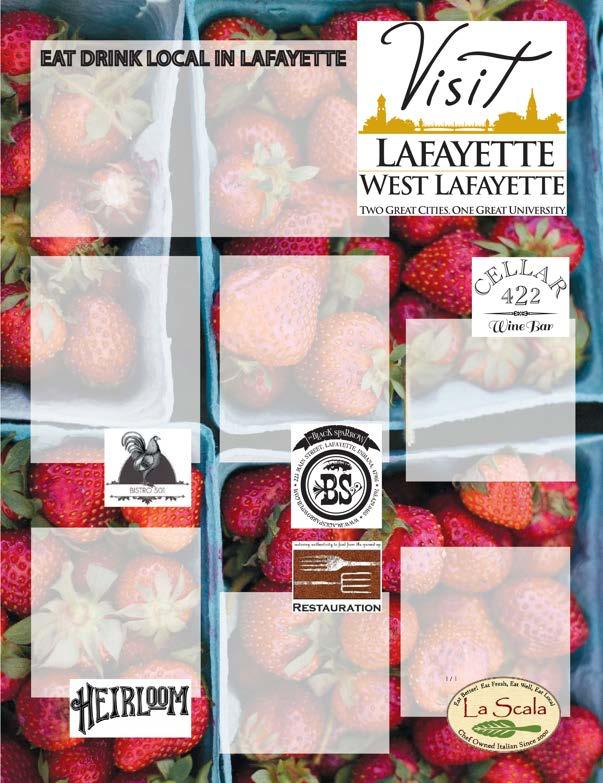
Heirloom Restaurant is a farm-to-table restaurant located in downtown Lafayette with a seasonal menu that supports local, sustainable agriculture. Regionally sourced artisan producers provide the best possible quality and freshness to your table.
102 N. 3rd St., Lafayette HeirloomIndiana.com
765.807.0422
We are happy to offer: whiskey, gin, tequila, craft cocktails, LOTS OF GOOD BOOZE, coasters, brick walls, art, PLEASING ASTHETIC, plates, silverware, unique pub food, seasonal dishes, DELICIOUS FARE, eclectic wines, ipas, sour ales, stouts, pilsners, domestics, ROTATING DRAFT & WINE SELECTION, staff that loves all of these things. Cheers!
223 Main St., Lafayette BlackSparrowPub.com
765.429.0405
Two sisters bring a love of delicious and affordable wines from around the world to the Lafayette area. We offer wines by the glass or bottle, to enjoy here or carry out, as well as a nice selection of craft beers. Enjoy fresh-made dishes that complement wine in a charming vintage atmosphere.
422 Main St., Lafayette
765.746.6754
Restauration, from the same owners as La Scala, is focused on farm-to-table, seasonal eating. We make everything from whole ingredients, often local, even from our own farm. Very allergen and special diet friendly. Restoring authenticity to food from the ground up!
731 Main St., Lafayette RestaurationLafayette.com
765.250.3970
Greater Lafayette’s favorite Italian food, serving the community for 16 years. We are known for handcrafted dishes, local ingredients and a large selection. We even have our own farm. Eat fresh. Eat well. Eat local.
312 Main St., Lafayette LaScalaItalianRestaurant.com
765.420.8171

Historic St. Joesph Brewery & Public House isn’t just a brewery, it’s a gastronomical success. From the bar to the kitchen, C&T Design provides distinctive kitchen design and equipment supplies making each project individual, custom and unique. The beer flows a little better with C & T Design.